|
|

This chapter describes the hardware and related functions for each line card in an IGX node. The description of each card includes:
A brief description of optional peripherals and third-party equipment appears at the end of the chapter. For system specifications, such as protocols and standards, refer to Appendix A.
For all matters relating to installation, troubleshooting, user-commands, and repair and replacement, refer to the Cisco IGX 8400 Series Installation manual.
Other manuals that relate to IGX operation are:
This chapter introduces each of the following line card groups:
Table 4-1 lists the front cards that operate in an IGX switch. Table 4-2 lists the ATM UNI interface cards, and Table 4-3 lists the interface cards for all other transport types that an IGX node supports.
In addition to the native front and back cards, an IGX switch can use existing IPX 16/32 service module cards in conjunction with an Adapter Card Module (ACM). The ACM cards connect to IPX 16/32 front cards and perform the adaptation necessary to allow IPX cards to operate in an IGX node. Note that this IPX upgrade feature cannot utilize IPX 8-specific cards. Beyond this limitation, IPX back cards can operate in an IGX system without modifications.
| interface Type, Card Acronym | Card Name |
|---|---|
| ATM UNI | |
UXM | Universal Transmission Module |
ALM/A | ATM Line Module, Model A |
| Voice | |
UVM | Universal Voice Module |
CVM-ADPCM | Channelized Voice Module, ADPCM |
CVM-T1 | Channelized Voice Module, T1 |
CVM-E1 | Channelized Voice Module, E1 |
| Frame Relay | |
UFM-4C | Universal Frame Module-Channelized (supports 4 lines on back card) |
UFM-8C | Universal Frame Module-Channelized (supports 8 lines on back card) |
Universal Frame Module-Unchannelized (for HSSI, V.35, or X.21) | |
FRM | Frame Relay Module, unchannelized, V.35/X.21 |
FRM-2 | Frame Relay Module, Port Concentrator only |
FRM-31 | Frame Relay Module, channelized, with 31 channels |
| Serial Data | |
HDM | High-speed Serial Data Module |
LDM | Low-speed Serial Data Module |
| Access Device | |
FTM | Frame Trunk Module |
| Card Acronym | Card Name |
|---|---|
| UXM ATM UNI | |
BC-UAI-4-155-MMF | 4-port Multi-Mode Fiber 155 Mbps |
BC-UAI-4-155-SMF | 4-port Single Mode Fiber 155 Mbps |
BC-UAI-2-155-SMF | 2-port Single Mode Fiber 155 Mbps |
BC-UAI-6-T3 | 6-port T3 back card |
BC-UAI-3-T3 | 3-port T3 back card |
BC-UAI-6-E3 | 6-port E3 back card |
BC-UAI-3-E3 | 3-port E3 back card |
BC-UAI-8-T1-DB15 | 8-port T1 back card with DB15 connector |
BC-UAI-8-E1-DB15 | 8-port E1 back card with DB15 connector |
BC-UAI-8-E1-BNC | 8-port E1 back card with BNC connector |
BC-UAI-4-T1-DB15 | 4-port T1 back card with DB15 connector |
BC-UAI-4-E1-DB15 | 8-port E1 back card with DB15 connector |
BC-UAI-4-E1-BNC | 4-port E1 back card with BNC connector |
| ALM/A | |
BC-UAI-1T3 | Universal ATM Interface T3 Back Card |
BC-UAI-1E3 | Universal ATM Interface E3 Back Card |
| Interface Type, Card Acronym | Card Name |
|---|---|
| Voice | |
BC-UVI-2TIEC | Universal Voice Interface T1 Card |
BC-UVI-2E1EC | Universal Voice Interface E1 Card |
BC-UVI-2J1EC | Universal Voice Interface J1 Card |
BC-E1 | E1 Interface Card |
BC-T1 | T1 Interface Card |
BC-Y1 | Y1 Trunk Interface Card |
BC-J1 | J1 User (Circuit) Interface Card |
BC-SR | Subrate Trunk Interface Card |
| Frame Relay | |
UFI-8T1-DB15 | Universal Frame Interface 8 T1 Card (with DB15 connectors) |
UFI-8E1-DB15 | Universal Frame Interface 8 E1 Card (with DB15 connectors) |
UFI-8E1-BNC | Universal Frame Interface 8 E1 Card (with BNC connectors) |
UFI-4HSSI | Universal Frame Interface 4 HSSI (supports 4 HSSI lines) |
UFI-12V.35 | Universal Frame Interface 12 V.35 (supports 12 V.35 lines) |
UFI-12X.21 | Universal Frame Interface 12 X.21 (supports 12 X.21 lines) |
FRI-T1 | Frame Relay Interface Card (supports T1) |
FRI-E1 | Frame Relay Interface Card (supports E1) |
FRI-V.35 | Frame Relay Interface Card (supports V.35) |
FRI-X.21 | Frame Relay Interface Card (supports X.21) |
| Data | |
SDI | Synchronous Data Interface: EIA/TIA-232C, EIA/TIA-232D, EIA/TIA-422/449, X.21, V.24, and V.35 |
LDI | Low-Speed Data Interface: EIA/TIA-232C/D, 4-port, 8-port |
| Access Device | |
FPC | Frame Port Card |
Front cards and back cards have faceplates with indicator LEDs and, on some front cards, push-button controls. In addition, back card faceplates have cable connectors. In slots where no back card exists, a blank faceplate must reside to contain Electromagnetic Interference (EMI) and Radio Frequency Interference (RFI) and to ensure correct air flow.
The LED indicators are on the front and back card faceplates. Each plug-in card has both a green Active LED and a red Fail LED at the bottom of the faceplate. In general, the meaning of each LED is indicated in Table 4-4. Some other cards have additional indicators, connectors, or controls, which the appropriate sections describe.
| Indicators | Status | Meaning |
|---|---|---|
Fail | ON Steady | Indicates an error occurred. Reset the card with the resetcd f command. If the LED comes on again, call the TAC. |
Fail | Blinking | On an NPM in a redundant system, this combination indicates that the card is being updated. |
Active | ON steady | When steadily on, this combination indicates the card is active and carrying traffic or processing data. |
Active | ON momentarily | When momentarily on, indicates the card executed a self-test. |
both | OFF | Indicates the card part of a redundant pair and is in the standby mode or not being used at all. |
both | ON | Indicates the card failed but remains active because no standby card is available. In the case of an HDM or LDM card, this could indicate that one or more of the data channels failed, but the others are still active. |
Cisco can upgrade IPX service/interface cards for use in an IGX node. This allows the IGX node to provide all the services of the IPX with cards of proven efficiency, functionality, and reliability. The upgrade is available only as a factory upgrade. The factory upgrade consists of an adding one of three possible Adapter Card Modules (ACM) and possible firmware or hardware modifications. Due to the complexity of the ACM, field upgrades of IPX cards are not possible.
Connecting IPX front cards to their corresponding back cards on the IPX requires the use of a utility or local bus. On upgraded IPX cards (IGX cards), the local or utility bus is not necessary.
The following IPX cards can be adapted for use in the IGX node:
This description of the Universal Switching Module (UXM) covers the following topics:
The Universal Switching Module (UXM) can function in one of two modes. In port mode, the UXM serves as either an ATM User-to-Network Interface (UNI) or a Network-to-Network (NNI) interface. In trunk mode, the UXM supports trunks in the network. The back cards support multiple ports operating at OC3/STM-1, T3, E3, T1, or E1 rates.
The UXM can transport ATM cells to and from the Cellbus at a maximum rate of 310 Mbps in either direction. The UXM can support up to 4000 connections in port mode. A connection on a port can be either a cell-forwarding connection or a complex gateway connection.
The UXM communicates only ATM cells to either the network or the CPE. On the Cellbus, however, the UXM communicates either ATM cells or FastPackets. With another UXM, it communicates only in ATM cells. With other cards, the UXM communicates in FastPackets. Through its gateway functionality, the UXM translates between FastPackets and ATM cells so it can transport voice, data, or Frame Relay traffic that other cards have put in FastPackets.
Networks with both trunk mode and port mode UXMs appear in Figure 4-1 and Figure 4-2, respectively. The nodes in Figure 4-1 use only UXMs for port interfaces and trunk interfaces. Figure 4-2 shows a variety of cards providing interfaces for different traffic types.
The network carrying only ATM traffic appears in Figure 4-1. Each UXM trunk card in Figure 4-1 connects to either another UXM trunk card or a BXM operating as a trunk. The ATM UNI ports are the UXM port cards (for connection A), the BXM operating in port mode (for connection B), the ASI (for connection C), and the BXM feeder trunk (for connection D). Connection D is a two-segment connection. One segment of connection D exists between the BNM and AUSM on the Cisco MGX 8220 shelf, and the other segment exists between the BXM and the UXM UNI port.
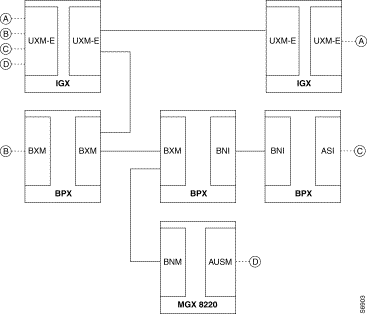
A network with ATM traffic and FastPacket-based traffic appears in Figure 4-2. Connections A and B are ATM connections that terminate on UXM UNI port cards and a BXM operating as a UNI port. Connection C is a Frame Relay connection between a UFM and an FRM. Connection D is a voice connection between a CVM and CDP. Connection E is a local connection between a UFM and a UXM UNI port (thus terminating on the same node). For connections C-E, the gateway function of the UXM packs and unpacks the FastPackets into and out of the ATM cells.
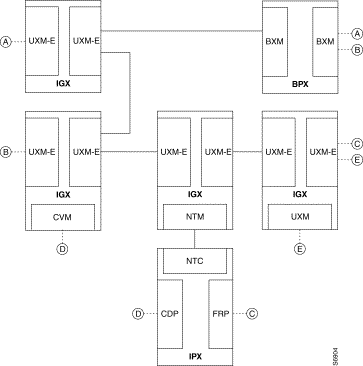
The following list broadly identifies the features of the UXM. After the bulleted list, the remaining sections of this introduction contain tables that list the features on particular topics, such as interworking. Actual descriptions of the features appear in the section titled "The UXM in UNI/NNI Port Mode."
Table 4-5 is a list of the UXM back cards. Figure 4-3 shows the UXM front card. Table 4-6 defines all possible combinations for the states of the front card status LEDs (Fail, Active, and Standby).
| Card Name | Card Description |
|---|---|
BC-UAI-4-155-MMF | 4-port Multi-Mode Fiber 155 Mbps |
BC-UAI-4-155-SMF | 4-port Single Mode Fiber 155 Mbps |
BC-UAI-2-155-SMF | 2-port Single Mode Fiber 155 Mbps |
BC-UAI-6-T3 | 6-port T3 back card |
BC-UAI-3-T3 | 3-port T3 back card |
BC-UAI-6-E3 | 6-port E3 back card |
BC-UAI-3-E3 | 3-port E3 back card |
BC-UAI-8-T1-DB15 | 8-port T1 back card with DB15 connector |
BC-UAI-8-E1-DB15 | 8-port E1 back card with DB15 connector |
BC-UAI-8-E1-BNC | 8-port E1 back card with BNC connector |
BC-UAI-4-T1-DB15 | 4-port T1 back card with DB15 connector |
BC-UAI-4-E1-DB15 | 8-port E1 back card with DB15 connector |
BC-UAI-4-E1-BNC | 4-port E1 back card with BNC connector |

| Fail | Active | Standby | Status of Card |
|---|---|---|---|
On | Off | Off | Failed |
Blinking | Blinking | Off | Back Card Mismatch (hot standby) |
Blinking | On | Off | Back Card Mismatch (active)—can be missing back card |
Blinking | Off | Blinking | Back Card Mismatch (self-test) |
Blinking | Off | On | Back Card Mismatch (standby) |
Off | Blinking | Off | Hot Standby |
Off | On | Off | Active |
Off | Off | Blinking | Self-test |
Off | Off | On | Standby |
On | On | On | Down |
Switch software limits the number of logical trunks and ports on an IGX switch. The maximum number of UNI or NNI ports in an IGX switch is 64. The maximum number of logical trunks is 32. To determine the number of each logical type in the switch, add the number of ports on multiport cards and single-port cards. These sums cannot exceed 64 ports and 32 trunks. For example, using exclusively 2-port OC3 trunks, you could install:
Switch software monitors the number of logical ports and trunks, not the number of UXMs. Therefore, the software keeps you from activating an excessive number of lines or trunks on the node rather than flagging the presence of too many cards.
The UXM features hot standby as a part of its Y-cable redundancy capability. With hot standby, the redundant card receives the configuration information as soon as you finish specifying redundancy. The standby card also receives updates to its configuration as the active card configuration changes. Hot standby lets the backup card go into operation as soon as necessary rather than waiting for the NPM to download the configuration
Y-cable redundancy requires that both cards are active and available before you set up redundancy. Use StrataView Plus or the CLI commands upln, then addyred. (See also descriptions of addyred, delyred, dspyred, and prtyred in the Cisco WAN Switching Command Reference.)
If the card fails, a switchover occurs to a Y-cabled, redundant UXM card set if available. If the switchover occurs, the primary UXM acquires failed status, and the Fail LED turns on.
The UXM informs switch software of the number and type of interface ports when you first activate the card. Software retains the back card configuration data if you remove a back card. If you subsequently attach a card with fewer ports, switch software flags a mismatch. Replacing a back card with more ports of the same line type or exchanging SMF and MMF OC3 (STM-1) cards is not a mismatch. To change the interface that software has on record, you must first down the card then re-activate it. To read how to down a card, see the Cisco IGX 8400 Series Installation manual
Table 4-7 is a list of the traffic management features of the UXM.
| Card Mode | Supported Management Technology |
|---|---|
UNI/NNI Port and Trunk | Traffic classes are CBR, VBR, ABR, and UBR as well as ATM-to-Frame Relay service interworking (SIW) and network interworking (NIW). |
Trunk | Additional traffic classes are FastPacket-based or interworked connections: high-priority, time-stamped, non time-stamped, bursty data A, bursty data B. |
UNI/NNI Port | PCR-linked policing of ABR connections. |
UNI/NNI Port and Trunk | Partial packet discard (or tail packet drop) and early packet discard for AAL5 VCs. |
UNI/NNI Port | ABR options:
|
UNI/NNI Port | Per-VC queuing for ABR or UBR connections. |
UNI/NNI Port | Per-VC queuing for statistics for all connection types. |
UNI/NNI Port | User-configurable, per-VC congestion thresholds. |
UNI/NNI Port and Trunk | User-configurable, per-Qbin congestion thresholds. |
UNI/NNI Port | EFCI, Relative Rate, or Explicit Rate control options for an ABR connection—if the ABR control loop does not terminate at the connection endpoints. |
A UXM line or trunk can provide the clock for the node. Use the dspclksrcs command to display available clock sources, dspcurclk to show the current clock source, and cnfclksrc to specify a new clock source. To clear clock alarms, use clrclkalm.
The Cellbus consists of four operational lanes plus one backup lane. (The backup lane becomes active if a lane fails.) The FastPacket-based cards can use only one lane and communicate only in FastPackets. If a FastPacket-based card controls the Cellbus, no ATM cells can be on the Cellbus.
When the UXM has control of the Cellbus, it can pass any of the following:
Switch software monitors and computes Cellbus bandwidth requirements for each card in the Cisco 8400-series switches. For the UXM alone, you can change its Cellbus bandwidth allocation. (You cannot view or alter bandwidth allocation for other cards.) The unit of measure for the ATM cell and FastPacket bandwidth on the Cellbus is the universal bandwidth unit (UBU).
Switch software allocates a default number of UBUs for the card when the UXM identifies the back card interface to switch software. If you remove a card, switch software reserves the current Cellbus bandwidth allocation for that card. If, as you add more connections, the load approaches oversubscription, switch software displays a warning message. Regardless of the warning message, Cisco advises you to monitor bandwidth allocation and allocate more UBUs for the card to avoid oversubscription.
For the UXM, switch software allocates enough bandwidth to meet the requirements for the minimum cell rate (MCR) and therefore does not accommodate burstiness. Therefore, you must know the UXM bandwidth requirements to determine if you should change its UBU allocation. Monitor the bandwidth requirements after you build the network and during normal operation. On the CLI, the applicable commands are cnfbusbw and dspbusbw.
You can raise, lower, or check a UXM's UBUs with cnfbusbw. The cnfbusbw privilege level is 0—superuser. To check a UXM's UBUs, use dspbusbw or cnfbusbw. Any user can use dspbusbw. Each command's display provides the information you need to determine if you must increase the UBUs on a particular UXM. The only value you can change is allocated bandwidth. An example display for cnfbusbw appears in Figure 4-4. The card-based default and maximum Cellbus bandwidth for each interface appears in Table 4-7. Note that FastPackets require substantially less Cellbus bandwidth than ATM cells. The FastPacket requirements in the figure and table reflect the restriction of FastPackets to one lane and the maximum processing rate of the gateway on the UXM. The values you can view with the cnfbusbw and dspbusbw commands are:
sw197 TN StrataCom IGX 16 9.1 Apr. 7 1998 03:15 GMT
Bus Bandwidth Usage for UXM card in slot 5 Last Updated on 04/07/98 03:15:42
FPkts/sec Cells/sec UBUs
Minimum Reqd Bandwidth: 0 100100 26
Average Used Bandwidth: 0 0 0
Peak Used Bandwidth: 0 0 0
Maximum Port Bandwidth: - 288000 72
Allocated Bandwidth: 1
(Cell Only): - 4000
(Cell+Fpkt): 2000 3000
(Fpkts / 2 + Cells) <= 4000
Reserved Bandwidth: - 4000 1
This Command: cnfbusbw 5
Allocated UBU count:
| Inter- face Type | No. of Ports | Default UBUs | Default Cell Traffic Only (cps) | Default Cell + Fpkt Traffic (cps and fps) | Max. UBUs | Max. Cell Traffic Only (cps) | Maximum Cell + Fpkts Traffic (cps and fps) |
|---|---|---|---|---|---|---|---|
OC3 | 4 or 2 | 44 | 176,000 | 132,000, 88,000 | 235 | 708,000 | 473,000, 470,000 |
T3 | 6 or 3 | 24 | 96,000 | 72,000, 48,000 | 235 | 708,000 | 473,000, 470,000 |
E3 | 6 or 3 | 20 | 80,000 | 60,000, 40,000 | 235 | 708,000 | 473,000, 470,000 |
T1 | 8 | 8 | 32,000 | 24,000, 16,000 | 32 | 128,000 | 96,000, 64,000 |
T1 | 4 | 4 | 16,000 | 12,000, 8,000 | 16 | 64,000 | 48,000, 32,000 |
E1 | 8 | 10 | 40,000 | 30,000, 20,000 | 40 | 160,000 | 120,000, 80,000 |
E1 | 4 | 5 | 20,000 | 15,000, 10,000 | 20 | 80,000 | 60,000, 40,000 |
With the Network Modeling Tool™ (NMT), you can use the projected load for all UXMs in the network to estimate their Cellbus requirements. During normal operation, you can use StrataView Plus to obtain the trunk and port statistics then decide whether to use cnfbusbw to increase the UBU allocation. If you are using only the CLI, you would need to establish a virtual terminal (vt) session to each node then execute dspbusbw or cnfbusbw.
To determine how many UBUs are necessary, use the values for average bandwidth used (see Figure 4-4) in the following formula:

In most circumstances, the fps and cps values from average bandwidth used are sufficient. The peak bandwidth used values are primarily informational.
The information in Table 4-7 provides the ranges for the interface type. Note that, if you do the math according to the formula, you see that the value in the cells-alone column of Table 4-7 equals the result of adding half the FastPacket value to the cell value in the cells plus FastPackets column.
When you use dspbusbw, a yes/no prompt asks if you want firmware to retrieve the usage values. If you enter a "y," the UXM reads—then clears—its registers and thus restarts statistics gathering. If you enter an "n," switch software displays the current values that reside in control card memory (on the NPM). The values in memory come from the last update from the UXM.
The UXM can support trunking across a public ATM network such that virtual channel connections (VCCs) traverse a single virtual path trunk. This feature lets you map multiple trunks to a single port of a UNI. The UNI connects to either a public or private ATM network. The virtual trunk package is a lower-cost alternative to leased circuits but still has the full set of Cisco ATM traffic management capabilities. This application requires two UXMs and a clock from an external source. The rates can be OC-3/STM-1, T3/E3, or T1/E1.

Note the following characteristics of this form of trunking across a public network:
Refer to Figure 4-5 as you read the steps for the following example set-up:
Step 1 Connect a cable between each of the following:
Step 2 Configure trunk 8.1, 8.2, and 8.3 to use VPC 101, 102, and 103 respectively.
Step 3 Add 3 VPC connection from 9.1, 9.2, and 9.3 to 9.4. At the far end, use the same VPCs.
In port mode, the UXM can support up to 4000 virtual circuit (VC) or virtual path (VP) ATM connections and can operate as either an NNI or a UNI. The connections can be either ATM connections or FastPacket-based (gateway). A "gateway" connection requires the UXM to translate between FastPackets and ATM cells. For ATM cell-based traffic, no conversion takes place: only ATM cells in the ingress and egress directions traverse the Cellbus between the UXM port card and UXM trunk card.
Gateway connections are a class of resource for the UXM. When you add connections, the outcome of the routing process may reduce the number of available gateway connections. The forthcoming section "Routing Over Cell Trunks Only" describes the effect of route selection on this resource.
Operating in port mode, the UXM provides an interface for the following classes of ATM service: CBR, VBR, standard ABR with and without virtual source/virtual destination (VS/VD), ABR with ForeSight, and UBR. The connections on a port-mode UXM—including interworked and cell-forwarded connections—can terminate on the following endpoints:
The cards that serve as connection endpoints determine the possible types of connections. Table 4-9 shows the possible connection type according to the endpoints. In Table 4-9, VC connection is a virtual channel connection; VP connection is a virtual path connection; and ABRFST is ABR with ForeSight. Note that the cards at both ends of a connection must support VS/VD for you to add an ABR connection with VS/VD. For more detailed information on the connection types, refer to the ATM connection description in the Cisco System Overview or the description of the addcon command in the "ATM Connections" chapter of the Cisco WAN Switching Command Reference.
| Endpoints | Connection Types |
UXM and UXM | VP connections and VC connections: CBR.1, VBR.1-3, UBR.1-2, ABRFST, ABR.1 (with VS/VD), ABR.1 (without VS/VD) |
UXM and ALM/A
| VC connections: CBR.1, VBR.1-3 |
UXM and BXM | VP connections and VC connections: CBR.1, VBR.1-3, UBR.1-2, ABRFST |
UXM and ASI-T3 or ASI-E3 | VP connections and VC connections: CBR.1, VBR.1-3, UBR.1-2, ABRFST |
UXM and ASI-OC3 | VP connections and VC connections: CBR.1, VBR.1-3, UBR.1-2, |
UXM and AUSM | VP connections and VC connections: CBR.1, VBR.1-3, UBR.1-2, ABRFST |
UXM and UFM | ATM frame forwarding connections (HDLC frames to single VPI/VCI on an ATM interface): VBR.3, ABRFST |
UXM and FRP or FRM | ATM frame forwarding connections (HDLC frames to single VPI/VCI on an ATM interface): VBR.3, ABRFST |
UXM and FRSM | ATM frame forwarding connections (HDLC frames to single VPI/VCI on an ATM interface): VBR.3, ABRFST |
You can specify trunk cell routing only as an option when you add a connection between UXM, ASI, or BXM ports. When you enable trunk cell routing, switch software routes across only the cell-based trunk cards BNI, BXM, and UXM: no conversion to FastPackets occurs on the route. If you disable trunk cell routing, the routing process may select a FastPacket-based trunk and so decrement the number of available gateway connections. Also, using a FastPacket-based trunk may result in increased network delays. Therefore, enabling trunk cell routing is the preferred choice when you add a connection at a BNI, BXM, or UXM.
If you add connections at other port cards, such as a UFM or ALM/A, switch software does not display the trunk cell routing option.
On the CLI, the addcon prompt for this option appears as "trunk cell routing restrict y/n?" It appears after you enter either the ATM class of service or after you finish specifying all the individual bandwidth parameters that apply to the current connection type. You can specify whether the default for trunk cell routing is "Yes" or "No" through the cnfnodeparm (superuser) command.
When you insert a new UXM into the backplane or apply power to the node, the UXM reports the card type and number of lines on the back card. Switch software can then determine the allowed range and characteristics of logical and physical parameters for you to configure. Software thus prevents you from exceeding the maximum number of logical ports on the switch as you activate logical lines through either StrataView Plus or the upln command on the CLI. Applicable, line-specific commands are upln, dnln, cnfln, dsplns, prtlns, and dsplncnf.
Table 4-10 shows the line characteristics you can configure for each interface type through either StrataView Plus or the cnfln command on the CLI. Table 4-10 also shows the fixed parameters.
| Interface Type | Configurable Parameters |
OC3 (STM-1) SMF and MMF |
|
T3 |
|
E3 |
|
T1 |
|
E1 |
|
You can specify the depths as well as high and low thresholds for the CBR, VBR, and ABR queues. (UBR service shares the ABR queue.) You can configure all queues to have the maximum queue size. If congestion occurs, firmware scales down the maximum queue size on the active ports. The maximum size for each queue for the ingress and egress directions is 64000 cells each, so the total for the logical ports on a card is 128000 cells.
For ABR queues, additional parameters are available through StrataView Plus or the cnfabrparm command. The additional parameters are Ingress/Egress Congestion Information (CI) Control and Egress Explicit Rate Stamping (ER). The settings apply to all ports. With CI Control enabled, the CI bit in each resource management (RM) cell in the queue is set if the EFCI threshold is exceeded. If you enable ABR ER, the cell rate for the ABR connection is placed in each of the RM cells.
On the CLI, you can specify summary statistics for a UXM port.
With the dspportstats command, you can specify:
With the dspchstats command, you can specify:
You can configure bucket statistics through StrataView Plus for logical lines, ports, and channels (connections). Statistics configuration in StrataView Plus requires the TFTP mechanism. You can also enter commands on the CLI. Refer to the Cisco WAN Switching Command Reference and the Cisco SuperUser Command Reference for descriptions of the following commands:
Integrated alarms for the UXM consist of LOS, LOF, AIS, YEL, LOC, LOP, Path AIS, Path YEL, Path Trace, and Section alarms. The display for the dsplns command lists an alarm if the related event occurs. You can configure the event duration that qualifies and clears an alarm with cnflnparm.
You can configure the class, rate, and duration for setting and clearing of statistical alarms with the cnflnalm command. Refer to the description of cnflnalm in the Cisco WAN Switching Command Reference for a list of all possible line alarm types. The display for the dsplnerrs command shows data for existing alarms. To clear the statistical alarms on a line, use the clrlnalm command.
The UXM supports local and remote loopbacks. You can establish a local loopback on either a connection or a port. Remote loopbacks are available for connections only. No line loopbacks are available for the UXM.
This section provides basic information on the interface back cards for the UXM. The information consists of a general description, an illustration of the card faceplate, and a table describing the connectors and status LEDs. For details on the line technology of each type of interface, see the appendix titled "System Specifications."
The model numbers of the back cards and the order of their appearance are:
The OC3/STM-1 back cards for the UXM have the single-mode fiber (SMF) and multi-mode fiber (MMF) connections. The cards are:
As indicated by the "2" or the "4" in the model number, these cards have two or four transmit and receive connectors. Each line has a tri-color LED whose color indicates its status. Each card also has a red Fail LED and a green Active LED to indicate the status of the card. Table 4-12 lists the connectors and LEDs. Figure 4-8 shows the four-port OC3/STM-1 card. The SMF and MMF versions appear the same. Figure 4-9 shows the two-port OC3/STM-1 card. For technical data on OC3/STM-1 lines, see the appendix titled "System Specifications."
| Connector/Indicator | Function |
|---|---|
Transmit and Receive | SC connector for SMF and MMF |
Red (on the tri-color LED) | On indicates line is active but a local alarm was detected. |
Yellow (on the tri-color LED) | On indicates line is active but a remote alarm was detected. |
Green (on the tri-color LED) | On indicates line is active. |
Fail light (red) | An error was detected. Reset the card with resetcd f to clear it. If Fail comes on again, call the TAC through Cisco Customer Engineering. |
Active light (green) | The card is active and in service. |

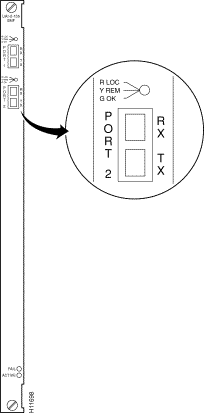
The T3 back cards for the UXM are BC-UAI-6-T3 and BC-UAI-3-T3. These cards have six and three pairs of SMB connectors, respectively. Each port has a tri-color LED whose color indicates its status. Each card also has a red Fail LED and a green Active LED to indicate the status of the card. Table 4-12 lists the connectors and LEDs. Figure 4-8 show the six-port T3 card. Figure 4-9 shows the three-port T3 card. For technical data on T3 lines, see the appendix titled "System Specifications."
| Connectors/Indicator | Function |
|---|---|
Transmit Jacks | SMB connectors for transmit data. |
Receive Jacks | SMB connectors for receive data. |
Red (on the tri-color LED) | On indicates line is active but a local alarm was detected. |
Yellow (on the tri-color LED) | On indicates line is active but a remote alarm was detected. |
Green (on the tri-color LED) | On indicates line is active. |
Fail light (red) | An error was detected. First, reset the card with resetcd f. If Fail |
Active light (green) | The card is active and in service. |


The E3 back cards for the UXM are the six-port BC-UAI-6-E3 and the three-port BC-UAI-3-E3. These cards have six and three pairs of connectors, respectively. Each line has a tri-color LED whose color indicates its status. Each card also has a red Fail LED and a green Active LED to indicate the status of the card. Table 4-13 lists the connectors and LEDs. Figure 4-10 show the six-port card. Figure 4-11 shows the three-port card. For technical data on E3 lines, see the appendix titled "System Specifications."
| Connector/Indicator | Function |
|---|---|
Transmit Jack | SMB connector for transmit data. |
Receive Jack | SMB connector for receive data. |
Red (on the tri-color LED) | On indicates line is active but a local alarm was detected. |
Yellow (on the tri-color LED) | On indicates line is active but a remote alarm was detected. |
Green (on the tri-color LED) | On indicates line is active. |
Fail light (red) | An error was detected. Reset the card with resetcd f to clear it. If Fail comes on again, call the TAC through Customer Engineering. |
Active light (green) | The card is active and in service. |
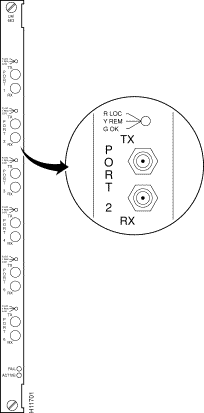
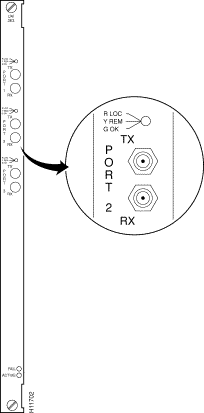
The T1 back cards for the UXM are BC-UAI-8-T1 and BC-UAI-4-T1. These cards have eight and four DB15 lines, respectively. Each line has a tri-color LED whose color indicates its status. If a card failure occurs, all the LEDs turn red. Table 4-14 lists the connectors and LEDs. Figure 4-12 show the eight-port T1 card. Figure 4-13 shows the four-port T1 card. For technical data on T1 lines, see the appendix titled "System Specifications."
| Connector/Indicator | Function |
|---|---|
Four or Eight DB15s | Each DB15 connector carries transmit and receive data. |
Red (on the tri-color LED) | On indicates line is active but a local alarm was detected. |
Yellow (on the tri-color LED) | On indicates line is active but a remote alarm was detected. |
Green (on the tri-color LED) | On indicates line is active. |
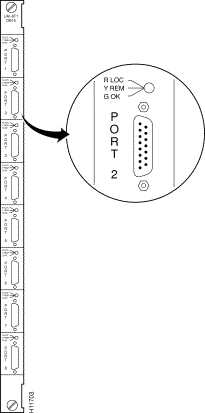

The E1 back cards for the UXM are:
As the model numbers indicate, the eight and four-port E1 cards can have either BNC or DB15 connectors. Each line has a tri-color LED whose color indicates its status. If a card failure occurs on the back card, all LEDs turn red. Table 4-12 lists the connectors and LEDs. Figure 4-8 show the eight-port E1 card. Figure 4-9 shows the four-port T1 card. For technical data on E1 lines, see the appendix titled "System Specifications."
| Connector/Indicator | Function |
|---|---|
Eight or Four DB15 Connectors | Each DB15 connector carries transmit and receive data. |
Eight or Four Pairs of BNC Connectors | Each BNC connector carries traffic in one direction. |
Red (on the tri-color LED) | On indicates line is active but a local alarm was detected. |
Yellow (on the tri-color LED) | On indicates line is active but a remote alarm was detected. |
Green (on the tri-color LED) | The card is active and in service. |
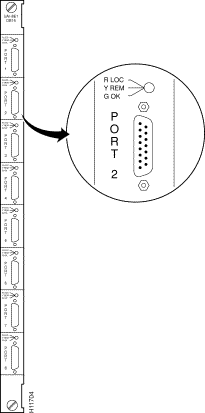
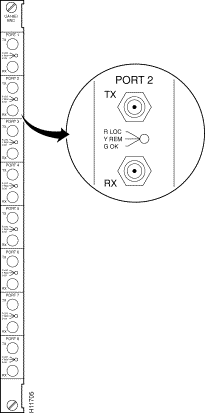
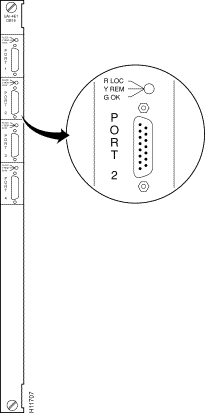

Using the addcon command, you can add connections between the following endpoints
Figure 4-18 shows an example of a network using ALMs. The network contains connections from an ALM/A to another ALM/A, a UFM, and an ASI. The dashed lines show virtual connections. The solid lines between the trunk cards and the ATM cloud are trunks.
Figure 4-19 shows the ALM/A faceplate.


A general list of ALM/A characteristics follows. (Subsequent sections have more particular information on interworking, traffic management, and back cards.)
The ALM/A supports CBR, VBR, ATFR, ATFT, and ATFX connection types. Thus, the card supports ATM, cell forwarding, and both network and service interworking connections. Table 4-16 shows the card combinations and connections types. The Cisco IGX 8400 Series Installation manual describes where and when to specify the connection type. For more information on the interworking connections, see the System Manual and the addcon description for Frame Relay and ATM connections in the Cisco WAN Switching Command Reference.
| Far-End Card | Possible Connection Types on the ALM/A |
|---|---|
ALM/A | VBR, CBR, ATFR, ATFT, ATFX |
UFM | ATFR, ATFT, ATFX |
FRM | ATFR |
ASI | VCCs only: VBR, CBR, ATFT, ATFR |
The ALM/A uses per-VC queue thresholds and credit-based servicing to control the ingress flow of data to the network and guarantee card resources for each connection.
Using addcon for an ATM or cell-forwarding connection, you specify the VC queue depth and the rate for the connection. If you do not specify a queue depth, the system calculates the queue depth for the connection based on the cell rate. The connection rate determines the service credits. If 80% of the VC queue depth is exceeded, cells with CLP=1 are discarded. If a connection's VC queue is full and the cell rate is exceeded long enough, cells are discarded from the affected queue. Therefore, if a high level of bursty traffic expected for given cell rate, specify a deeper queue for a connection.
For cell forwarding connections, you can explicitly assign VC queue depth for each connection. For ATFR connections, you can assign a VC queue depth by choosing or modifying a Frame Relay class and specifying the queue depth in bytes. Either way, you can over-subscribe the buffer pool on the card. Actually, buffers are dynamically assigned to VC queues as cells arrive and depart. In this scheme, no data is lost unless you over-subscribe and all buffers are occupied. If you do not specify VC queue depth when adding a connection, switch software assigns a percentage of buffers equal to the connection's cell rate divided by the total ALM/A bandwidth. With this approach, over-subscription is not a problem.
The ALM/A has the following operational parameters:
The ALM/A T3 and E3 back cards are the BC-UAI-1T3 and BC-UAI-1E3, respectively. Each back card has two BNC connectors and six LED indicators. For the BC-UAI-1T3 faceplate items, refer to Figure 4-20 and Table 4-17 . For the BC-UAI-1E3 faceplate items, refer to Figure 4-21 and Table 4-18. As you read from the top-down, the items in the figure and table correlate to each other. For technical specifications on T3 and E3 lines, refer to the appendix titled "System Specifications."
| Connector/Indicator | Function |
|---|---|
Transmit Jack | BNC connector for transmit data. |
Receive Jack | BNC connector for receive data. |
LOS light (red) | Loss of signal at the local end. |
Red alarm light (red) | Loss of local T3 or E3 frame alignment or loss of cell alignment. |
Yellow alarm light (yellow) | Loss of frame alignment at remote end or loss of cell alignment. |
AIS light (green) | All ones on the line. |
Fail light (red) | An error was detected. Reset the card with resetcd f. If the LED comes on again, call the TAC. |
Active light (green) | The card is in service and has active circuits. |
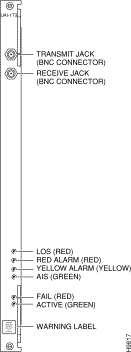
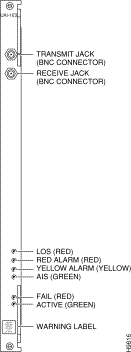
| Connector/Indicator | Function |
|---|---|
Transmit Jack | BNC connector for transmit data. |
Receive Jack | BNC connector for receive data. |
LOS light (red) | Loss of signal at the local end. |
Red alarm light (red) | Loss of local T3 or E3 frame alignment or loss of cell alignment. |
Yellow alarm light (yellow) | Loss of frame alignment at remote end or loss of cell alignment. |
AIS light (green) | All ones on the line. |
Fail light (red) | An error was detected. Reset the card with resetcd f. If the LED comes on again, call the TAC. |
Active: light (green) | The card is in service and has active circuits. |
This section describes the Universal Voice Module (UVM) and its interface cards, as follows:
For installation and configuration instructions, see the Cisco IGX 8400 Series Installation manual.
The UVM card set is a multi-purpose module capable of supporting channelized T1, E1, or J1 lines for carrying voice, data, or both these types of traffic. The voice coding that the UVM supports are:
G.729 and G.729A are two versions of CSACELP. G.729A is simpler and can permit a greater number of channels on a UVM. On the other hand, it does not support certain features, such as FAX relay. The applicability of G.729 or G.729A appears as needed throughout this UVM description. The text frequently distinguishes connection types by referring to the standard.
A UVM can terminate connections to a:
The sections that follow (up to the descriptions of the UVM faceplates) describe the UVM features.
The features of the UVM are:
For voice connections that use PCM, ADPCM, or G.729A, the UVM can operate in either 24-channel mode (T1) or 30-channel mode (E1 or J1). If the compression is LDCELP or G.729 CSACELP, the UVM supports up to 16 channels. If more than 16 channels on a T1, E1, or J1 line are to carry traffic with G.729 or LDCELP, the UVM must pass the remaining DS0s on to an second, adjacent UVM for processing. The name of this setup is pass-through.
When a configuration requires pass-through, one UVM port connects to user-equipment, and the other port connects to another UVM. For a description of this feature, see "Channel Pass-Through ."
A brief description of each type of voice and data connection appears in Table 4-19. To specify the connections, use either StrataView Plus or the CLI. The CLI command is addcon.
| Type | Description |
p | Carries 64-Kbps PCM voice and supports A-law or µ-law encoding and conversion, gain adjustment, and signaling. |
v | Carries 64-Kbps PCM voice with VAD. |
t | Carries clear channel data at 64 Kbps. |
td | Carries compressed data for VNS signaling. The typical rate is 16 Kbps or lower. |
a32 | Specifies ADPCM only. You can specify 32 Kbps or 24 Kbps. This type of connection is also permissible for modems. |
c32 | Specifies both ADPCM and VAD. You can specify 32 Kbps or 24 Kbps. |
l16 | LDCELP compression of voice to 16 Kbps. |
l16v | LDCELP compression of voice to 16 Kbps with VAD. |
g729r8 | CSACELP voice compression at 8 Kbps according to G.729. |
g729r8v | CSACELP voice compression at 8 Kbps with VAD according to G.729. |
g729ar8 | CSACELP voice compression at 8 Kbps according to G.729A. |
g729ar8v | CSACELP voice compression at 8 Kbps with VAD according to G.729A. |
n x 64K | Super-rate (data) connections where n <= 8. |
The "t,", "td," and "n x 64" connections carry signalling or user-data. All other types carry voice. You can configure any of the voice connections for FAX or modem upgrade.
This section contains a list of the standard commands and the superuser commands you can use on the CLI for voice and data connections on the UVM. Table 4-20 lists the standard commands. Table 4-21 lists the superuser commands. For details on command syntax and parameters, refer to the Cisco WAN Switching Command Reference and the Cisco SuperUser Command Reference. Note that the superuser commands have infrequent use, and many of them are strictly for debug purposes.
| Command | Function |
♦ upln | Use upln to activate the line. |
♦ cnfln | Use cnfln to specify the characteristics of the T1, E1, or J1 line for voice or data. |
♦ cnfcassw | If the UVM must convert CAS/DTMF to CCS signaling for a Voice Network Switch (VNS), use cnfcassw to configure the UVM for CAS-switching. |
♦ cnflnpass | For a UVM intended to carry voice traffic with LDCELP or G.729 CSACELP, cnflnpass configures the lines for pass-through feature if necessary. Before you can execute cnflnpass, you must activate the lines (upln) and configure them (cnfln). |
♦ cnfchadv | Configures the channel for adaptive voice. |
♦ cnfchdl | Configures a channel's dial-type. The options are inband, pulse, and user-configured. |
♦ cnfchec | Configures certain characteristics of the echo canceller for each channel. |
♦ cnfchgn | Configures the amount of gain inserted in a voice channel. |
♦ cnfcond | Configures a conditioning template for the channel. |
♦ cnfrcvsig | Configures receive signaling for the channel. |
♦ cnfxmtsig | Configures transmit signaling for the channel. |
♦ cnfvchtp | Configures a voice interface type for the channel. |
♦ cnfchutl | Configures channel utilization (the cnfchutl description is in the "Optimizing Traffic Routing and Bandwidth" chapter of the Cisco WAN Switching Command Reference). |
♦ addyred | Enables redundancy for the UVM card set. |
♦ dsplncnf | Use dsplncnf to make sure you have correctly configured the line. |
♦ addcon | Adds voice or data connections. |
| Command | Function |
♦ clrcderrs | Clears the history of errors on a card. |
♦ cnfchstats | Enables statistics collection for various channel parameters for different cards, some of which apply to the UVM. |
♦ cnfclnparm | Configures the alarm integration time for a line. |
♦ cnfclnsigparm | Configures signaling parameters. |
♦ cnfclnstats | Customizes statistics collection on each circuit line. |
♦ cnfcmparm | Configures parameters that affect adaptive voice, rerouting, and courtesy up/down. These parameters apply at only the local node. |
♦ cnfecparm | Configures more specific details of integrated echo canceller (IEC) operation for a specified voice line. |
♦ cnfuvmchparm | Configures defaults for the following parameters for a channel or range of channels: voice codec unit (VCU) level, PCM interface unit (PIU) level, VAD threshold, modem threshold, and silence threshold. |
♦ cnfvchparm | Specifies the following UVM card parameters: voice activity detection (VAD), background noise injection, voice frequency channel loss, echo suppression, and automatic bandwidth upgrade level upon modem tone detection. |
♦ dchst | Displays card parameters—for debug purposes. |
♦ dspcderrs | Displays error information resulting from a diagnostic running on the local card. |
♦ dspchan | Displays the data structure defining a voice channel for debug purposes. |
♦ dspecparm | Displays statistics configured for a selected echo canceller. The cnfecparm command sets up the statistics. |
♦ dsplnstatcnf | Displays statistics configured for a line. |
♦ dspsig | Displays the current signaling state received at the node from a voice channel. |
♦ dspslot | Displays system information associated with a specific card in the node. |
♦ dsputl | Displays the utilization factor for all voice connections on a circuit line. |
Pass-through is a setup in which two, locally connected UVMs support the maximum number of channels on a T1, E1, or J1 line.
A single UVM can support mixed connection types and compression algorithms. For example, you can add a combination of ADPCM, LDCELP, or CSACELP connections. Any combination is possible if the configuration does not exceed the capacity of the card.
The maximum number of channels that can use G.728 (LDCELP) or G.729 compression is 16, so not all possible channels on a line are used if they are using LDCELP or G.729 CSACELP. To use all possible channels on a line with these compression types, you must configure pass-through by using a second UVM. Pass-through, for example, lets a PBX trunk use all of its bandwidth when the only compression is LDCELP or G.729 CSACELP.
In the pass-through scheme, a primary UVM connects through a cable to a secondary UVM. The primary UVM passes the unprocessed channels to the secondary UVM. Pass-through applies to LDCELP or G.729 CSACELP. The G.729A version CSACELP does not require pass-through because one UVM can support all the channels on a line.
You can configure pass-through by using StrataView Plus or the command line interface (CLI). The CLI command for specifying pass-through is cnflnpass. For a description of how to set up pass-through, refer to the Cisco IGX 8400 Series Installation manual. For a detailed description of the cnflnpass command, refer to the Cisco WAN Switching Command Reference.
When you are setting up pass-through, switch software does not allow you to duplicate the channel numbers once you have added the channels to the primary UVM. With UVMs in slots 7 and 8, for example, if you add 16 channels with LDCELP to the primary UVM in slot 7 (7.1.1-16), the system prevents you from adding channels 8.1.1-8. Instead, you would add 8.1.17-24.
The possible arrangements for E1 or J1 lines appear in Figure 4-22. It shows:
The three possible arrangements of UVMs with T1 lines appear in Figure 4-23. It shows:


The UVM supports standard, 64-Kbps data connections and super-rate (n x 64) data connections. Data connections can terminate on a CVM or a UVM. The super-rate connections can support an aggregate of up to eight, 64-Kbps channels—frequently used for video. These super-rate channels should be contiguous or, if necessary, alternating.
The UVM extracts information from the CAS signaling bits in the T1, E1, or J1 frame. When a signaling bit changes state, the UVM sends signaling packets to the card at the other end of the connection. CSS signaling, such as DPNSS and ISDN signaling, are supported through a clear (transparent) channel. The supported combinations of signaling and line configurations are:
In addition to the preceding, the UVM can set, invert, and clear AB or ABAB bits (T1) or ABCD bits (for E1 or J1) to accommodate some signaling conversions.
On the CLI, use cnfln to specify the signaling and dsplncnf to see the signaling configuration.
Up to 23 voice interface types, such as 2-W E&M, FXO/FXS, or DPO/DPS, can be selected from a template to condition the VF signaling. You can also customize the signal conditioning. Refer to the descriptions for the cnfcond and cnfvchtp commands in the Cisco WAN Switching Command Reference for details. You can program voice channel signaling for any of the following:
The FAX relay feature compresses the DS0 bit stream of a G3 FAX (9.6 Kbps) connection to 9.6 Kbps for transport through the network. (If the bit stream for the FAX is lower, the UVM compresses it to that lower rate.) The UVM supports FAX relay for LDCELP and G.729 (but not G.729A) connections. Interworked connections between an IGX node and Cisco 3810 access device can also carry FAX relay data.
You can specify FAX relay by using the cnfchfax command. The maximum number of FAX relay channels on a UVM is 16. Once you have enabled it, FAX relay overrides the automatic FAX upgrade feature—but a data modem still upgrades to PCM or ADPCM. (The automatic upgrade feature suspends compression when a modem or FAX tone appears on a voice connection.)
You can set up local and remote loopbacks to check UVM-terminated connections. A local loopback functions at the system bus interface. It returns data and supervision back to the local facility to test the local UVM card set and the customer connection. Remote loopbacks extend to the UVM card at the far-end and check both transmission directions and much of the far-end UVM. For descriptions of the commands that support loopbacks, refer to the Cisco WAN Switching Command Reference.
The UVM card set monitors and reports statistics on the following input line conditions:
The back cards support two clock modes. You select the mode through software control (cnfln on the CLI). The clock modes are normal clocking and loop timing.
With normal clocking, the UVM supplies the transmit clock for outgoing data (towards the CPE).
With loop timing, the UVM uses the receive clock from the line for the incoming data and redirects this receive clock to synchronize the transmit data.
The UVM supports CAS for Voice Network Switching (VNS) by converting CAS signaling and DTMF tones to CCS call-control messages. These signal conversions let the VNS unit route calls from a PBX over a WAN. For setup instructions, see the VNS documentation and the Cisco WAN Switching Command Reference.
The converted CCS messages for all channels on the line travel on a regular t-type or a special td-type PVC connection from the UVM to another UVM card. The VNS device can receive the CCS messages from t-type or td-type PVC connections on the signaling channel of CAS-switching UVM cards in the network.
When the VNS unit receives a CCS call-control message, it determines the destination from the control message and issues SNMP commands to add a connection from a channel on the CAS switching line to the destination across the network. CAS-switching in a network appears in Figure 4-24.
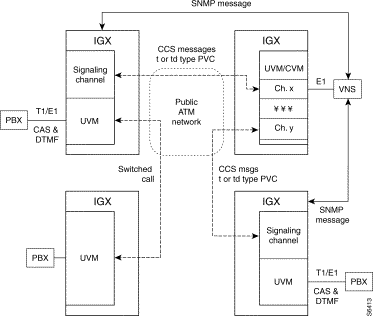
The limitations on CAS-switching with Model C or Model D firmware are:
Refer to VNS documentation for a full description of this product.
D-channel compression applies to the Cisco Voice Network Switching (VNS). The minimum VNS release is 3.1. This feature compresses the signaling traffic between the application UVM and the network (VNS) UVM. D-channel compression reduces the consumed bandwidth from 64 Kbps per VNS signaling channel to 16 Kbps or less. It applies to CCS lines or CAS lines that where the CAS-switching feature is operating.
D-channel compression switches on when you add the signaling connection through StrataView Plus or by using the addcon command on the CLI. To turn on D-channel compression, specify the connection type as "td." The maximum number of "td" connections on a UVM is 32.
The UVM supports a feature that accelerates call setup and teardown for frequently used channels. The feature is voice SVC caching. It works in conjunction with VNS. The only consideration for the UVM is that you must configure each line to accommodate voice SVC caching.
On the CLI, use the cnfln command to enable this feature on the line and dsplncnf to see the configuration. If you configure a line for voice SVC caching, you can still add standard voice connections on that line. Note that you cannot enable SVC caching on pass-through lines.
For a more detailed description of voice SVC caching, refer to the VNS documentation.
Table 4-22 and Figure 4-25 describe the front card faceplate.
| LED | Meaning |
Active (green) | Indicates card is active. |
Fail (red) | Indicates self-test has detected a card failure. |
Major (red) | A line failure has been detected on the receive (local) side. |
Minor (yellow) | A line failure has been detected at the remote end. |

The BC-UVI-2T1EC back card provides two T1 line interfaces for a UVM card. The features of the BC-UVI-2T1EC are:
B8ZS supports clear channel operation because B8ZS eliminates the possibility of a long string of 0s. B8ZS is preferable whenever available.
Figure 4-26 and Table 4-23 provide information on the faceplate of the BC-UVI-2T1EC. When you correlate the descriptions in the table with the callouts in the figure, read from the top of the table to the bottom. The standard port connector is a female DB15.

| Connector/Indicator | Function |
|---|---|
Transmit/Receive (2) | Two, bi-directional DB 15 connectors—one for each port. |
Port Status LED (2) | Tri-color LED, 1 per port. Green=active port. Yellow=remote alarm. Red=local alarm. |
Fail LED (red) | Error detected. Reset card with resetcd f. If LED comes on again, call the TAC. |
Active LED (green) | The card is in service and has active circuits. |
The BC-UVI-2E1EC back card provides an E1 circuit line interface for a UVM. The BC-UVI-2E1EC provides the following features:
Figure 4-27 shows and Table 4-24 lists status LEDs and connections on the BC-UVI-2E1EC faceplate. When you correlate the table and figure items, read from the top to the bottom.

| Connector/Indicator | Function |
|---|---|
Transmit/Receive DB 15 (2) | Two, bi-directional DB 15 connectors—one for each port. |
Transmit/Receive BNC (4) | Two pairs of BNC connectors—one receive connector and one transmit connector for each port. |
Port Status LED (2) | Tri-color LED, 1 per port. Green=active port. Yellow=remote alarm. |
Fail LED (red) | Error detected. Reset the card with resetcd f. If LED comes on again, call the TAC. |
Active LED (green) | The card is in service and has active circuits. |
RMFRA/YMFYA | Two-color LED: Red (RMFRA) indicates local loss of multiframe alignment. Yellow (YMFYA) indicates loss of multiframe alignment at remote end. |
The BC-UVI-2J1EC back card provides a J1 line interface for a UVM card. The BC-UVI-2J1EC does the following:
Figure 4-28 shows and Table 4-25 lists status LEDs and connections on the BC-UVI-2J1EC faceplate. When you correlate the table and figure items, read from the top to the bottom.
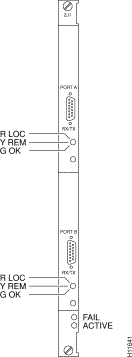
| Connector/Indicator | Function |
|---|---|
DB15 connectors | Two, bi-directional DB15 connectors—one for each port. |
Port Status LED (two) | Tri-color LED, one per port. Green=active port. Yellow=remote alarm. Red=local alarm. |
Fail LED (red) | Error detected. Reset card with resetcd f. If the LED comes on again, call the TAC. |
Active LED (green) | The card is in service and has active circuits. |
This section introduces the Channelized Voice Module (CVM) and its related back cards. The topics covered in this section are as follows:
For setup instructions, see the Cisco IGX 8400 Series Installation manual and the relevant commands in the Cisco WAN Switching Command Reference (voice-specific commands are in the chapter titled "Voice Connections").
The CVM is a multi-purpose front card. A CVM circuit line can carry the following types of traffic:
The default mode for a channel on a CVM is voice. In addition to other CVMs, a CVM can communicate with a CDP in an IPX or one of the ports on a UVM. Figure 4-29 illustrates different traffic configurations. You can use the CVM in either 24-channel mode (T1) or 30-channel mode (E1). You assign the circuits on a CVM hop on a per-timeslot basis within a T1 or E1 frame.
The CVM cards can reside in any non-reserved slot in an IGX node. The front card operates with either a BC-T1, BC-E1, or BC-J1 back card. For details on back cards, see the forthcoming sections titled "T1 Interface Back Card (BC-T1) ," "E1 Interface Back Card (BC-E1)," or "BC-J1 Description ."
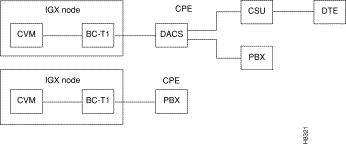
The following is a list of CVM features.
This section describes the operational parameters you can specify for the CVM card set. Table 4-26 is a list of the types of CVM operation. The sections that follow further describe the listed subjects.
The first two entries in Table 4-26 are the two types of 64-Kbps operation. The "p" indicates uncompressed PCM voice. The "t" indicates 64 Kbps clear channel data. The table then shows voice and data modes, transmit/receive rates, and indications of compression and ZCS (zero code suppression). A "c" or an "a" preceding a numerical value indicates compression. A "c" indicates compression with voice activity detection (VAD), so "c" does not apply to data connections. An "a" indicates compression without VAD. The "a" can apply to either voice or data. The numerical value following the "a" or "c" is the bit rate. Table 4-26 also explains the significance of the other characters that may follow the bit rate.
Standard-rate (64 Kbps) voice connections terminate on CVM or UVM T1 or E1 lines. (The CVM can terminate a connection from a UVM only if the connection does not use LDCELP.) You can configure the voice compression, and echo cancelling for each channel, and—when circumstances make it appropriate—A-law or µ-law encoding. You can select voice frequency compression of 64 Kbps (no compression), 32 Kbps (2:1), 24 Kbps (3:1), or 16 Kbps (4:1). The compression ratios approximately double when you also enable the internal VAD.
| Type | Description |
p | A p-connection carries 64 Kbps PCM voice and supports A-law or µ-law encoding and conversion, gain adjustment, and signaling. |
v | A v-connection carries compressed voice. |
t | The t-connections carry 64 Kbps clear channel data traffic. |
cxx | cxx signifies compression with VAD. When you use a CVM for voice and specify compression, you must specify the level of ADPCM compression by the xx field after the "c"." Enter 32 for 2:1 compression, 24 for 3:1 compression, or 16 for 4:1 compression. For example "c16" indicates 4:1 voice compression with VAD. |
a16z | c16z and a16z use a 4-sample, 16-Kbps ADPCM that does not ensure ones-density. The "z" directs the node not to route a16z or c16z-type connections across ZCS-configured trunks. |
a16 | c16 and a16 are non-standard forms of compression. They use a 4-sample, 16-Kbps ADPCM that ensures ones-density but results in a loss of voice quality. You can route a16 and c16-type connections across ZCS-configured trunks. |
a32d | a32d and c32d provide compression for FAX on a high-speed line (such as Enhanced Instafax) without causing errors. Compression begins when the CDP/CVM/UVM detects a high speed modem. You must specify a32d or c32d (cnfvchparm on the CLI). If you do not specify a32d or c32d, the circuit operates at 56/64 Kbps when the card detects a high-speed modem or FAX. Note that, if you choose c32d (compression with VAD), it provides the bandwidth savings associated with VAD only when the line is actually being used for voice. |
a32 | Specifies ADPCM only. You can specify 32-Kbps or 24-Kbps. |
c32 | Specifies both ADPCM and VAD. You can specify 32-Kbps or 24-Kbps. |
The particular voice features are:
In addition to the preceding, the CVM can set, invert, and clear AB or ABAB bits (T1) or ABCD bits (E1) to accommodate some signaling conversions.
A CVM can provide data connections to the network. Data connections that originate on a CVM can terminate on a CVM, UVM, HDM, or LDM in an IGX switch. In an IPX switch, data connections that originated on a CVM can terminate on a CDP, SDP, or LDP.
Two categories of data connections exist on the CVM. The categories are super-rate and subrate. A super-rate connection is an aggregate of DS0s. A super-rate connection can consist of any combination of 56 or 64 Kbps-connections up to a maximum of 8 DS0s. The channels must be contiguous or alternating. The 56-Kbps channels are bit-stuffed up to 64 Kbps on the line. The CVM removes the bits prior to packetization. Note that super-rate connections carry no supervisory bits.
A subrate data connection has a rate less than 64 Kbps and exists within a DS0. Supported rates are 2.4, 4.8, 9.6, and 56 Kbps. The type of subrate data connection that Cisco supports is DS0A. In-band DS0A link codes are translated into EIA control lead states for HDM or LDM-to-CVM connections. Fast EIA, Repetitive Pattern Suppression (RPS), and isochronous clocking are not available.
The CVM extracts information from the signaling bits in the E1 or T1 frame. When a signaling bit changes state, the CVM generates signaling packets to the CVM at the other end of the connection. DPNSS and ISDN signaling are supported through a clear channel (transparent mode). The supported combinations of signaling and line configurations are as follows:
Up to 23 voice interface types, such as 2-W E&M, FXO/FXS, or DPO/DPS, can be selected from a template to condition the VF signaling. You can also specify customized signal conditioning. Voice channel signaling is programmable for any of the following:
The CVM supports a feature that accelerates call setup and teardown for frequently used channels. The feature is voice SVC caching. It works in conjunction with VNS. The only consideration for the CVM is that you must configure the line to accommodate voice SVC caching. On the CLI, use the cnfln command to configure the line for this feature and dsplncnf to see the configuration. If you configure a line for voice SVC caching, you can still add standard voice connections on that line. For a more detailed description of voice SVC caching, refer to the VNS documentation.
The CVM card set monitors and reports statistics on the following input line conditions:
On the CLI, use cnfln to specify the signaling and dsplncnf to see the signaling configuration.
You can set up local and remote loopbacks to check CVM-terminated connections. A local loopback functions at the system bus interface. It returns data and supervision back to the local facility to test the local CVM card set and the customer connection. Remote loopbacks extend to the CVM card at the other end and check both transmission directions and much of the far-end CVM.
The CVM faceplate has four LED indicators: Active, Fail, Major, and Minor (see Table 4-27). The label on the faceplate also shows the type of CVM card.
| LED or Label | Description |
Active (green) | Indicates card is active. |
Fail (red) | Indicates self-test has detected a card failure in the main card or optional integrated echo canceller board. |
Major (red) | A line failure has been detected on the receive (local) side. |
Minor (yellow) | A line failure has been detected at the remote end. |
CVM | A label indicating standard CVM |
CVM ADPCM T1 | A label indicating T1 with echo cancelling circuitry |
CVM ADPCM E1 | A label indicating E1 with echo cancelling circuitry |
The BC-T1 back card provides a T1 line interface for a CVM card. It provides the following:
B8ZS supports clear channel operation because B8ZS eliminates the possibility of a long string of 0s. B8ZS is preferable whenever available.
The back cards support two clock modes. You select the mode through software control (cnfln on the CLI). The clock modes are normal clocking and loop timing.
With normal clocking, the BC-T1 supplies the transmit clock for outgoing data (towards the CPE).
With loop timing, the BC-T1 uses the receive clock from the line for the incoming data and redirects this receive clock to synchronize the transmit data.
Figure 4-30 and Table 4-28 provide information on the faceplate of the BC-T1. When you correlate the descriptions in the table with the callouts in the figure, read from the top of the table to the bottom. The standard port connector is a female DB15.
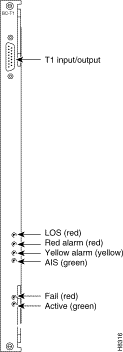
| Connector/Indicator | Function |
|---|---|
T1 input/output | Female DB15 connector for T1 line. |
LOS light (red) | Indicates loss of signal at the local end. |
Red alarm light (red) | Indicates loss of local E1 frame alignment, or it indicates loss of packet alignment on the CVM. |
Yellow alarm light (yellow) | Loss of frame alignment at remote end or loss of packet alignment (CVM). |
AIS light (green) | Indicates the presence of all ones on the line. |
Fail light (red) | Indicates an error occurred. Reset the card with the resetcd f command. If the LED comes on again, call the TAC. |
Active: light (green) | Indicates the card is in service with active circuits. |
The BC-E1 back card provides an E1 line interface for a CVM. It has the following features:
The back cards support two clock modes. You select the mode through software control (cnfln on the CLI). The clock modes are normal clocking and loop timing.
With normal clocking, the BC-E1 supplies the transmit clock for outgoing data (towards the CPE).
With loop timing, the BC-E1 uses the receive clock from the line for the incoming data and redirects this receive clock to synchronize the transmit data.
The node keeps statistics on most line errors and fault conditions, including the following:
Figure 4-31 shows and Table 4-30 lists status LEDs and connections on the BC-E1 faceplate.

| Connector or LED | Function |
|---|---|
RX-TX | Female DB15 connector for XMT and RCV E1. |
RX | BNC connector for receive E1 line. |
TX | BNC connector for transmit E1 line. |
LOS light (red) | Loss of signal at the local end. |
Red alarm (red) | Loss of local E1 frame alignment. On CVM, Red indicates loss of packet alignment. |
Yellow alarm (yellow) | Loss of frame alignment at remote end. On CVM, Yellow shows loss of packet alignment. |
AIS light (green) | Indicates the presence of all ones on the line. |
MFRA (red) | Loss of multiframe alignment. |
MFRY (yellow) | Loss of multiframe at remote end. |
Fail light (red) | Indicates an error occurred. Reset the card with resetcd f. If the LED comes on again, call the TAC. |
Active: light (green) | Indicates the card is in service with active circuits. |
The BC-J1 back card provides a Japanese J1 circuit line interface for a CVM. The BC-J1 does the following:
The back cards support two clock modes. You select the mode through software control (cnfln on the CLI). The clock modes are normal clocking and loop timing.
With normal clocking, the BC-J1 supplies the transmit clock for outgoing data (towards the CPE).
With loop timing, the BC-J1 uses the receive clock from the line for the incoming data and redirects this receive clock to synchronize the transmit data.
Figure 4-32 shows a BC-J1 faceplate. Table 4-30 lists BC-J1 connections and status LEDs.
| Connector or LED | Function |
RX-TX | Female DB15 connector for XMT and RCV J1. |
Line in | J1 trunk input line. |
Line out | J1 trunk output line. |
RX MON | BNC test connector for monitoring receive J1 line. |
TX MON | BNC test connector for monitoring transmit J1 line. |
LOS light (red) | Indicates loss of signal at the local end. |
Red alarm light (red) | Indicates loss of local frame alignment. |
Yellow alarm light (yellow) | Indicates loss of frame alignment at the remote end. |
AIS light (green) | Indicates the presence of all ones on the line. |
MFRA light (red) | Indicates loss of multiframe alignment. |
MFYA light (yellow) | Indicates loss of multiframe at the remote end. |
Fail light (red) | Indicates an error occurred. (First, reset the card with resetcd f. If the LED comes on again, call the Cisco TAC. |
Active light (green) | Indicates the card is in service and that circuits are active. |

This section applies to only CVMs (and CDPs in an IPX node) that are Model C. Model C provides a service called Time Division Multiplexing Transport (TDM Transport). TDM Transport bundles DS0s to form a single, transparent connection through the network. TDM Transport is most valuable for transporting TDM data from trunks in older, non-Cisco WANs. For setup instructions, see the Cisco IGX 8400 Series Installation manual and the command descriptions in the Cisco WAN Switching Command Reference.
The Model C firmware features are as follows:
The limitations on TDM Transport within Model C firmware are as follows:
To achieve full T1 and E1 rates on a single CVM or CDP, TDM Transport supports inverse multiplexing. Figure 4-32 shows a simple example. In this example, the three, bundled 512-Kbps data connections symbolized by the arrows add up to a T1 connection.
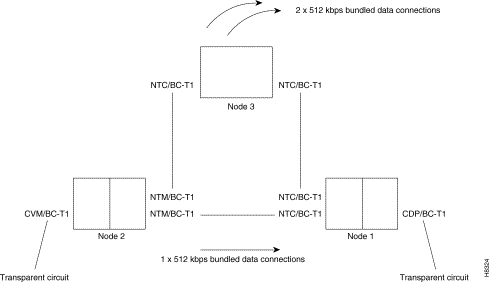
This section describes the Frame Relay service cards. The Frame Relay cards consist of the UFM (Universal Frame Module) family of front and back cards and the FRM (Frame Relay Module) family of front and back cards. The first part of this section contains information that applies to both the UFM and FRM card sets. Subsequent sections contain information that is particular to individual front and back cards. The Frame Relay and individual card topics are:
See the Cisco IGX 8400 Series Installation manual for installation steps. For technical details on the line types of individual back cards, see the appendix titled "System Specifications." For a description of Frame Relay on a FastPAD, see the section titled "Data Cards" later in this chapter.
This section lists information that applies to Frame Relay service. The first list describes functions at the node-level and the network interface. The second list contains card-specific information.
An IGX Frame Relay network features the following:
The FRM and UFM front cards perform the following functions:
The card places Frame Relay data into FastPackets. Frame relay flag bytes and bit-stuffing provide frame delimiting and transparency. If a user-data byte has a value of hexadecimal 7E, the card changes it by inserting 0s, so that the card does not process the byte as a flag. (The Frame Relay card uses flag bytes to fill partial FastPackets.)
For any Frame Relay card set that has a maximum frame length of 4510 bytes, the type of signaling protocol you may (optionally) specify with cnffrport results in a limit on the number of connections per physical or logical port. The maximum number of connections per port for each protocol is:
Neither addcon nor cnffrport prevents you from adding more than the maximum number of connections on a port. (You might, for example, use cnffrport to specify an LMI when too many connections for that particular LMI already exist.) If the number of connections is exceeded for a particular LMI, the LMI does not work on the port, the full status messages that result are discarded, and LMI timeouts occur on the port. A port failure results and also subsequently leads to a-bit failures in other segments of the connection path.
On an IGX node, Frame Relay over a T1 or E1 line requires one of the following combinations:
A Frame Relay T1/E1 connection can terminate on any Frame Relay Interface—V.35, X.21, T1 or E1.
Frame relay over a T1 or E1 interface supports groups of DS0 timeslots in a logical port. A logical port is a single DS0 or a group of contiguous DS0s. Logical ports consisting of multiple DS0s operate at the full rate of 64 Kbps per timeslot. If a logical port consists of a single DS0, you can configure either 56 Kbps or 64 Kbps. See Figure 4-34.
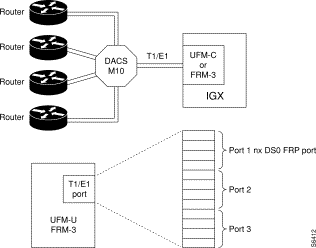
The Universal Frame Module (UFM) cards support a much higher port density than the FRM cards and support ELMI and Frame Relay-to-ATM service interworking. The front card (UFM-4C or UFM-8C) can support Frame Relay traffic on a maximum of 4 or 8 T1 or E1 ports on a back card. The front card (UFM-U) can support Frame Relay traffic on 12 V.35 ports, 12 X.21 ports, or 4 HSSI ports on a back card.
The next sections describe the UFM-C card sets. Subsequent sections describe the UFM-U card sets.
The Universal Frame Model (UFM-C) supports either 4 or 8 T1 or E1 ports per back card. The UFM-4C supports 4 ports regardless of the presence of the 8 connectors on the UFI back card. The UFM-8C supports all 8 ports. Both models of the UFM-C support 1 to 24 or 1 to 31 DS0s per physical line.
The UFM-C can also operate unchannelized for E1 only, with 32 DS0s constituting one unchannelized E1. In the unchannelized mode, one logical E1 port maps to one E1 line.
Table 4-31 lists the front and back cards described in this and subsequent sections.
| Front Cards | Back Cards | |
UFM-4C |
|
The characteristics and functions of the UFM-C are as follows:
Figure 4-35 shows a UFM-C faceplate. If the label on the faceplate shows "UFM C," the front card is a UFM-8C, which most UFMs are. The UFM-4C label shows "UFM-4C."

| LED | Meaning |
Active (green) | On indicates card is active. |
Fail (red) | On indicates self-test has detected a card failure. |
Major (red) | A line failure has been locally detected on one or more of the receive ports. |
Minor (yellow) | A line failure has been detected at the remote end on one or more of the receive ports. |
The Universal Frame Interface 8T1 (UFI-8T1-DB15) back card has 8, bi-directional, DB15 connectors. See Figure 4-36. For each port, one tri-color LED displays the status, as the emphasized area of Figure 4-36 shows. The line is inactive if the LED is off. See Table 4-33 .

| LED | Meaning |
Green | On indicates line is active. |
Red | On indicates line is active, but a local alarm was detected. |
Yellow | On indicates line is active, but a remote alarm was detected. |
Universal Frame Interface 8E1 cards have connectors for 8 E1 ports. The UFI-8E1-DB15 has 8 bi-directional DB15 connectors. The UFI-8E1-BNC has 16 BNC connectors (2 per port). See Figure 4-37. Each port has a tri-color LED for status display. See Table 4-34 . The line is inactive if the LED is off.
| LED | Meaning |
Green | On indicates line is active. |
Red | On indicates line is active, but a local alarm was detected. |
Yellow | On indicates line is active, but a remote alarm was detected. |

This section contains the following:
The back cards that provide line interfaces to the UFM-U are the:
The features and operational characteristics of the UFM-U card sets are as follows:
The aggregate throughput you can configure across all ports is 24.576 Mbps. The 24.576 Mbps is the maximum line speed and is the over-subscription ceiling. The actual data throughput of the card depends on the hardware and the frame size. As the frame size decreases, the throughput decreases. With a frame size of 200 bytes of more, for example, the sustainable throughput is 16.384 Mbps. With 100-byte frames, data may be dropped if the rate is 16.384 Mbps for significant time periods.
For a description of Cisco Frame Relay technology, see the Cisco System Overview.
Figure 4-38 shows the faceplate of the UFM-U. Table 4-35 describes its LED indicators. The first two columns of Table 4-35 shows the names of the LEDs and possible combinations of on and off states. The "Description" column describes the meaning of the LED states.

| Description | ||
|---|---|---|
Major LED | Minor LED | The Major and Minor LEDs apply to the UFM-U only. |
|
|
|
Active LED | Fail LED |
|
Unlit | Unlit | Card power is off. |
Unlit | Red | Card power is on, but no activation has been received; or an activation message has been received, but the card failed. |
Green | Red | A background diagnostic has failed. |
Green | Unlit | The card is active, and no failures have been detected. |
This section describes how to specify active ports and the maximum speed allowed on each active port. Specifying the maximum speed for active ports requires careful planning, and this section provides the information for understanding and planning the port specification.
The hardware does not permit random combinations of speeds across the ports. Hardware constrains the speeds to certain combinations of maximum rates on active ports. The combination of maximum speeds and active port numbers is called the mode of the card. Table 4-36 shows the maximum port speeds and additionally groups the ports under a letter. If you need to change the mode of a card after connections have been added, you must consider these port groups. The forthcoming section titled "Changing the Mode of a UFM-U " describes the application of port groups.
In rows 1 through 27 of Table 4-36, the numeric value is the maximum bit rate for the V.35, X.21, or HSSI port. The V.35 and X.21 ports have column headings 1 through 12 (and subheadings consisting of a group letter), and the HSSI port numbers are 1 through 4.
The maximum aggregate throughput is 16 Mbps. Note that, although the cnfmode command lets you specify the maximum for each active port, you specify the actual bit rate for a port with either the cnfport or cnffrport command. In Table 4-36:
| V.35 and X.21 Ports | HSSI Ports | ||||
|---|---|---|---|---|---|
| Group A | Group B | Group C | A | B | |
| Mode | 1 2 3 4 | 5 6 7 8 | 9 10 11 12 | 1 2 | 3 4 |
1 | 3 3 3 3 | 3 3 3 3 | 3 3 3 3 | 8 8 | 8 8 |
2 | 8 - 8 - | 8 - 8 - | 8 - 8 - | 16 - | 16 - |
3 | 10 - - - | 10 - - - | 10 - - - | 16 - | - - |
4 | 8 - 8 - | 3 3 3 3 | 3 3 3 3 |
|
|
5 | 10 - - - | 3 3 3 3 | 3 3 3 3 |
|
|
6 | 8 - 8 - | 8 - 8 - | 3 3 3 3 |
|
|
7 | 10 - - - | 8 - 8 - | 3 3 3 3 |
|
|
8 | 10 - - - | 10 - - - | 3 3 3 3 |
|
|
9 | 10 - - - | 8 - 8 - | 8 - 8 - |
|
|
10 | 10 - - - | 10 - - - | 8 - 8 - |
|
|
11 | 3 3 3 3 | 8 - 8 - | 3 3 3 3 |
|
|
12 | 3 3 3 3 | 3 3 3 3 | 8 - 8 - |
|
|
13 | 3 3 3 3 | 10 - - - | 3 3 3 3 |
|
|
14 | 3 3 3 3 | 3 3 3 3 | 10 - - - |
|
|
15 | 8 - 8 - | 3 3 3 3 | 8 - 8 - |
|
|
16 | 3 3 3 3 | 8 - 8 - | 8 - 8 - |
|
|
17 | 8 - 8 - | 10 - - - | 3 3 3 3 |
|
|
18 | 8 - 8 - | 3 3 3 3 | 10 - - - |
|
|
19 | 3 3 3 3 | 8 - 8 - | 10 - - - |
|
|
20 | 3 3 3 3 | 10 - - - | 8 - 8 - |
|
|
21 | 10 - - - | 3 3 3 3 | 8 - 8 - |
|
|
22 | 10 - - - | 3 3 3 3 | 10 - - - |
|
|
23 | 3 3 3 3 | 10 - - - | 10 - - - |
|
|
24 | 8 - 8 - | 10 - - - | 8 - 8 - |
|
|
25 | 8 - 8 - | 8 - 8 - | 10 - - - |
|
|
26 | 10 - - - | 8 - 8 - | 10 - - - |
|
|
27 | 8 - 8 - | 10 - - - | 10 - - - |
|
|
Initially, an unchannelized UFM card set comes up in mode 1. To specify another mode, use either cnfmode or cnfufmumode. The preferable time to specify a mode is before you add connections. After connections exist on the card, you must delete some or all connections and down ports before you change the mode. To change the mode of a card set, you must first delete all the connections in a group and down all the active ports in a group if any maximum port speed changes in a group as a result of the mode change. This requirement means you may or may not have to delete connections in a particular group. Use Table 4-36 to follow two examples that illustrate what you must do before you change modes.
1. If you change from mode 1 to mode 4 and connections exist on ports 1, 3, and 9-12, you must delete connections on 1 and 3 only and down these ports (no change in maximum speed on 9-12).
2. If you change from mode 2 to 9 and connections exist on all active ports, you must remove connections from ports 1 and 3 then down these ports (and relocate the connections from port 3 to port 1).
The steps for changing the mode of a UFM-U when connections exist on the card is as follows:
Step 1 Use the delcon command to remove all connections in any group where any maximum port speed changes because of the mode change.
Step 2 Use the dnport command to deactivate all ports in any group where any maximum port speed changes because of the mode change.
Step 3 Use the cnffrport command to configure new port speeds (at or below the new maximum resulting from the mode change).
Step 4 Use the cnfmode command to change the mode.
Step 5 Use the upport command to activate the inactive ports that are operational under the new mode.
Step 6 Use addcon to add connections as needed.
This section describes the standard cabling and the Y-cabling scheme for the unchannelized back cards. The back cards are the UFI-12V.35, UFI-12X.21, and UFI-4HSSI. Because of the port variety and because the cables are either DCE or DTE, a significant number of cable configurations exist. Table 4-37 shows cable names, part numbers, and descriptions.
The connectors on the UFI cards are high density. Each UFI-12V.35 and UFI-12X.21card has 6, 60-pin connectors. Each of these connectors has two ports. If your specification dictates that both ports on a connector are active, you must have a cable with wiring for two ports. If a part number in Table 4-37 has the form "CAB-2...," the cable has wiring for two ports. Note that if both ports on a connector are active, both ports must be either DCE or DTE because the cable itself is either DCE or DTE. If a connector has only one active port, the cable can be the less expensive, single-port version. A HSSI connector has 50 pins and supports one port.
| Card | Model Number | PCB Connector | Destination Connector | Cable Description |
|---|---|---|---|---|
HSSI | CAB-HSI 1 | 50-pin Male | 50-pin Male | HSSI Cable, UFI is DCE |
HSSI | CAB-HS1-DTE | 50-pin, Male | 50-pin Male | HSSI Cable, UFI is DTE |
HSSI | CAB-Y-HS1 | Two, 50-pin Male | 50-pin Male | HSSI Y-cable, 3 feet |
V.35 | CAB-V35MC | DB60F | V.35 | V.35 Cable, DCE, Male, 10 ft. |
V.35 | CAB-V35MT | DB60F | V.35 | V.35 Cable, DTE, Male, 10 ft. |
V.35 | CAB-V35FC | DB60F | V.35 | V.35 Cable, DCE, Female, 10 ft. |
V.35 | CAB-V35FT | DB60F | V.35 | V.35 Cable, DTE, Female, 10 ft. |
X.21 | CAB-X21MT | DB60F | X.21 | X.21 Cable, DTE, Male, 10 ft. |
X.21 | CAB-X21FC | DB60F | X.21 | X.21 Cable, DCE, Female, 10 ft. |
V.35 | CAB-2V35MT | DB60 Male | Two V.35 | V.35 Cable, DTE, Male 10 feet |
V.35 | CAB-2V35FC | DB60 Male | Two V.35 | V.35 Cable, DCE, Female 10 ft. |
V.35 & | CAB-Y-UFI | 2xDB60 Male | DB60 Female | UFI-specific Y-cable |
X.21 | CAB-2X21MT | DB60 Male | Two X.21 | X.21 Cable, DTE, Male, 10 ft. |
X.21 | CAB-2X21FC | DB60 Male | Two X.21 | X.21 Cable, DCE, Female, 10 ft. |
Port redundancy through the use of a Y-cable requires two card sets, at least one Y-cable, and the standard cabling. On a UFI-4HSSI, Port 1 is the only port that supports Y-cable redundancy. On the V.35 and X.21 UFIs, redundancy at more than one connector requires a corresponding number of Y-cables and standard cables. The standard cables are either single-port for HSSI, V.35, or X.21 or dual-port for the X.21 and V.35 UFIs.
To set up the Y-cabling, you attach a branch of the "Y" at the primary and redundant connectors then attach the near end of the standard cable to the base of the "Y." Figure 4-39 illustrates single and dual-cabling in a Y-cable setup. The single-cable arrangement applies to HSSI, V.35, and X.21. The dual-port redundancy setup applies to a UFI-12X.21 or UFI-12V.35, where both ports within the UFI connector are used in a Y-cable redundancy scheme.
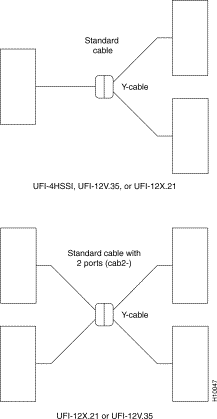
The UFI-12V.35 has six connectors. Each connector contains two V.35 ports. Each port has a tri-color LED to indicate its status. Because each connector supports two ports, each connector has two associated LEDs. Figure 4-40 shows the faceplate of the UFI-12V.35, and Table 4-38 describes the significance each color of the LED.
You can configure each port on the UFI-12V.35 to use normal clocking or a looped clocking, then configure the port to run at one of the following speeds:
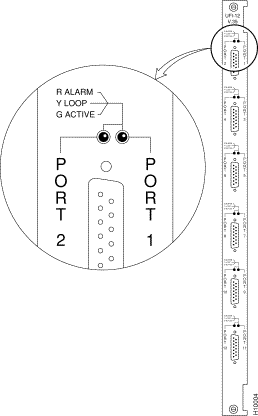
| LED | Meaning |
Green | Indicates line is active and functional. |
Red | Indicates line is active but either has no cable or the wrong cable or is running over-speed. |
Yellow | Indicates the line is active and in loopback mode. |
Off | Indicates that either the port is inactive or has no power. |
The UFI-12X.21 has six connectors. Each connector contains two X.21 ports. Each port has a tri-color LED to indicate its status. Because each connector supports two ports, each connector has two associated LEDs.
You can configure each port on the UFI-12X.21 to use normal clocking or a looped clocking, then configure the port to run at one of the following speeds:
Figure 4-41 shows the faceplate of the UFI-12X.21, and Table 4-39 describes the significance each color of the LED.
| LED | Meaning |
Green | Indicates line is active and functional. |
Red | Indicates line is active but either has no cable or the wrong cable or is running over-speed. |
Yellow | Indicates the line is active and in loopback mode. |
Off | Indicates that either the port is inactive or has no power. |
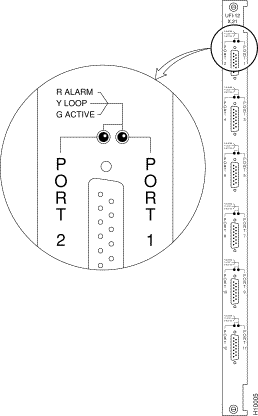
The UFI-4HSSI has four connectors. Each connector has a tri-color LED for status. Figure 4-42 shows the UFI-4HSSI faceplate. Table 4-40 describes the significance each color of the LED.
Using cnffrport, you can configure each port with a speed that is a multiple of 1 Mbps up to the maximum for the mode of the card (see the section titled "Port Speeds on the Unchannelized UFM").

| LED | Meaning |
Green | Indicates line is active and functional. |
Red | Indicates line is active but either has no cable or the wrong cable or is running over-speed. |
Yellow | Indicates the line is active and in loopback mode. |
Off | Indicates that either the port is inactive or has no power. |
The Frame Relay Module (FRM) front card supports 1 to 4 data ports and, in single-port mode, operates at up to 2.048 Mbps.
| Front Card | Model | Back Card | Model |
FRM Frame Relay Module, unchannelized | D | FRI-V.35 FRI-X.21 | B A |
FRM Frame Relay Module, channelized (with 31 channels) | E | FRI-T1 or FRI-E1 | A |
FRM2 Frame Relay Module, Port Concentrator Shelf | F | FRI2-X.21 | A |
The FRM supports a maximum port speed of 2.048 Mbps plus the following features:
The FRM can support a maximum of 252 virtual circuits (PVCs). PVC distribution can cross all four ports if they do not exceed the 252 PVC limit and the limit of 2.048 Mbps per FRM.
Bundled and grouped connections are software groupings of multiple virtual circuits within a single routing connection. Grouping allows a node to support up to 1024 virtual circuits, which is the logical equivalent of four FRMs.
Frame relay card redundancy can be provided through a second card set in adjacent slots and a Y-cable between each port that connects to the user-equipment. See Figure 4-43 for an illustration. The hardware kits for this feature contain a second Frame Relay card set, a set of Y-cables to interconnect the two card sets, and any other pieces that apply to the card types. Y-cable redundancy is not possible using back cards with different interfaces, such as an FRI T1 and FRI V.35.
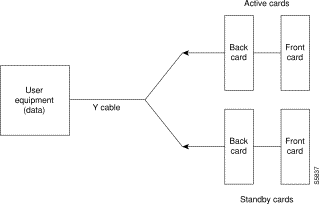
The Frame Relay Interface V.35 (FRI-V.35) is a four-port back card to the FRM card. Two models of the FRI-V.35 can support the FRM:
The FRI-V.35 has the following functions and features:
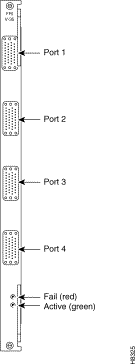
Table 4-42 shows the relationship between the number of ports used on the FRI and maximum operating speed for each port. Model A FRM and FRI cards are included for early users who may not have updated the cards. Note that the port numbers start at the top on the FRI faceplate.
| Firmware | One Port | Two Ports | Three Ports | Four Ports |
A/A | £ 256 | £ 256 | £ 256 | £ 256 |
| 1024 | 0 | 0 | 0 |
B/A | £ 256 | £ 256 | £ 256 | £ 256 |
| £ 336 | £ 336 | £ 336 | 0 |
| £ 512 | £ 512 | 0 | 0 |
| 1024 | 0 | 0 | 0 |
C/A | £ 256 | £ 256 | £ 256 | £ 256 |
| £ 336 | £ 336 | £ 336 | 0 |
| £ 512 | £ 512 | 0 | 0 |
| 1024 | 0 | 0 | 0 |
C/B | One port can operate at 2048 or 1920. Combinations of ports can add up to 2048 Kbps. If one port is 1920 or 2048, no other port can be active. | |||
Each Frame Relay logical channel has a number in the form:
where
The two clocking modes that the FRI supports are normal and looped. Figure 4-45 illustrates the two modes. Note that the direction for the clock and data is reversed for the two FRI mode configurations (DCE or DTE), as follows:

Figure 4-46 illustrates the FRI-T1 and FRI-E1 back cards.

The IGX node does not support port loopbacks (tstport and addextlp command) towards the IGX node. In contrast, for V.35 and X.21 interfaces only, you can set up connection loopbacks towards the facility by using the addloclp and addrmtlp commands.
The firmware on the front card must match the type of interface on the back card. Rev D firmware on the FRM supports X.21 and V.35 protocols. Rev E firmware on the FRM supports T1 and E1 protocols. The Display Card (dspcd) command indicates the type of back card that the FRM firmware supports and reports any mismatch.
The FRI-X.21 back card provides an X.21 interface to the user equipment. The two model D FRI cards are the FRI-V.35 and FRI-X.21. They differ only in the physical connectors (see Table 4-43). The operating rates of each port and the composite data rate supported by the FRI-X.21 card is the same as the FRI-V.35. You can configure each port as either a DCE or a DTE. Another FRI card is the FRI-2-X.21. This is the back card that provides the interface between the Port Concentrator Shelf (PCS) and the FRM-2. See the section titled "FRM-2 Interface to the Port Concentrator Shelf ."
The FRI-X.21 uses leased line service for international networks. The V.35 version is for domestic (U.S.) use and also uses a leased line service for its connections. The FRI-X.21 back card features:
FRI configuration supports one to four ports. The configuration depends on the maximum speed requirement (the card itself has a maximum composite speed). Figure 4-47 shows the FRI faceplate. Table 4-44 lists the available port operating speeds.
Any one port can operate at 2048 Kbps. Any combination of ports can equal 2048 Kbps. If a port is operating at 2048 Kbps, it must be port 1, and no other port can be active. Numbering of the 4 DB15 connectors starts at the top of the faceplate. Table 4-45 lists the cable and pinouts for an X.21 port.
| Back Card | Interface Type | Ports | Connector |
FRI-X.21 | X.21 | 4 ports | DB15 Sub miniature, female |
FRI-V.35 | V.35 | 4 ports | 34-pin MRAC type (Winchester), female |
| Individual Timeslots | Maximum Aggregate Rate |
Any multiple of 56 Kbps | Up to 1.792 Mbps |
Any multiple of 64 Kbps | Up to 2.048 Mbps |
| Pins | Mnemonic | Full Name | Mode |
1 | Gnd. | Protective (Shield) ground | DTE and DCE |
8 | Sig. Gnd. | Signal ground | DTE and DCE |
3/10 | C | Control | DTE and DCE |
5/12 | I | Indication | DTE and DCE |
2/9 | TxD | Transmit Data from DTE | DTE |
4/11 | RxD | Receive Data to DTE | DCE |
6/13 | S | Clock Out (DCE), Clock In (DTE) | DCE |

The FRI-X.21 supports only normal clock mode. The direction of the clock and data lines is reversed if the FRI is configured as a DCE or as a DTE as follows (see Figure 4-48):

The Y-cable redundancy kits for the FRI-X.21 and FRI-V.35 contain four extra daughter cards for specifying individual ports as either DCE or DTE. The extra daughter cards are 200-Ohm versions for the FRI already installed. The higher impedance cards are necessary because of circuit behavior at higher speeds when the two interfaces are in parallel (by way of the Y-cable).
As with all IGX cards, the FRI-X.21 includes internal diagnostic routines that periodically test the card's performance. These self-test diagnostics automatically start and run in background. They do not disrupt normal traffic. If a failure is detected during the self test, the faceplate red Fail LED is turned on. The operator can also view the status at the control terminal by executing the Display Card (dspcd) command.
A report of a card failure remains until cleared. A card failure is cleared by the Reset Card (resetcd) command. The two types of reset that resetcd can do are hardware and failure. The failure reset clears the event log of any failure detected by the card self-test but does not disrupt operation of the card. A reset of the card firmware is done by specifying a hardware reset. This reboots the firmware and momentarily disables the card. If a redundant card is available, the hardware reset causes a switch over to the standby card.
The X.21 Frame Relay ports and any associated external modems, CSUs, or NTUs can be tested using data loopback points in the circuit path. The three possible loopbacks for X.21 Frame Relay ports are:
The modems must be compatible with the Cisco loopback protocol. For information on supported modems and protocols, refer to the appendix titled "Peripherals Specifications" in the Cisco IGX 8400 Series Installation manual. Also, refer to the Cisco WAN Switching Command Reference for protocol requirements for the addextlp, addloclp, and addrmtlp commands. For information that applies to loopbacks on the FRM-2/FRI-2 and PCS, see the descriptions of these loopback commands in the Cisco WAN Switching Command Reference. If these sources fail to clarify a particular situation, contact the Cisco TAC.
All three loopbacks are set up using the tstport command. Only one port at a time can be in loopback mode for testing.
The internal loopback point is established inside the FRI card. Figure 4-49 illustrates the setup. The FRM generates a test pattern, sends it out on the transmit circuitry, and detects this pattern on the receive circuitry. This test takes several seconds and momentarily interrupts traffic on the port. The test runs on a port that is in either DCE or DTE mode.

For ports configured for DTE, the two additional tests (local loopback and remote loopback) are available. For these ports there are two methods of loopback testing:
FRI card replacement is the same as other back card replacement. For back card replacement procedures, refer to the Cisco IGX 8400 Series Installation manual.
This section introduces the Port Concentrator Shelf (PCS) for Frame Relay traffic. The PCS is an external device that expands the capacity of a Frame Relay Module (FRM) to 44 low-speed ports. This ability to increase the port density of an IGX switch supports more efficient usage for the common switch equipment. The port parameters are as follows:
The PCS requires a version of the FRM/FRI card set that is exclusively dedicated to the PCS. The front card is the FRM-2. The back card that interfaces the FRM-2 to the PCS is the FRI-2-X.21. Figure 4-50 illustrates the relation ship between the FRM/FRI card set and the PCS. It provides one or more X.21 links. Each X.21 link is called a concentrated link. In a full configuration, each concentrated link services one of four 11-port modules in the PCS. This makes a total of 44 ports on the FRM-2.
For more detailed information on the PCS, refer to the section on the Port Concentrator Shelf in the System Manual. For detailed installation instructions, refer to the Port Concentrator Installation document that comes with each unit. Cabling information for the PCS appears in the cabling appendix and in the Port Concentrator Installation document.
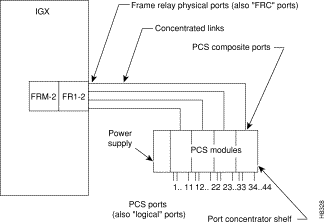
The following terms are used to identify PCS components:
Other than front panel LEDs, the PCS has no user interface because the PCS functions as an extension of the FRM-2. PCS ports are operated and maintained from the IGX user interface.
The PCS operates within the IGX environment as a Frame Relay card with 44 ports. Existing Frame Relay commands (cnffrport, upfrport, dnfrport, addcon, delcon, etc.) are the same in syntax and function. The difference is that a range of 44 ports can be specified instead of 4. The configuration of each of the PCS logical ports is similar to that of non-PCS Frame Relay ports. A Frame Relay card connected to a PCS notifies the system database and permits the additional ports to be specified.
This section describes the interface between the PCS and IGX node.
The PCS requires the following:
The concentrated link refers to the connection between port concentrator and Frame Relay card. Each module supporting 11 external ports is connected to 1 of the 4 ports on the FRI-2-X.21 back card.
Each of the four composite links between an PCS and IGX node has a fixed configuration of:
The PCS Concentrated Link cable is illustrated in the cabling appendix. Its maximum length is 25 feet. You cannot use a modem to extend this distance.
FRM-2 firmware interacts with the PCS over composite links only if the FRM-2 is active. The FRM-2 changes from standby to active state when its first logical port is activated.
A PCS logical port associated with an FRM-2 card is activated with the upfrport command. The upfrport command requires the slot number of the FRM-2 to which the PCS is connected. Enter the slot number and a logical port in the range of 1-44 (assuming a connection exists for all 4 composites between the PCS and IGX node).
This example indicates that the FRM-2 in slot 4 and concentrated link 1 are connected.
Entering the upfrport command for one port activates all four ports. The following events are generated by successful activation of four concentrated links. The display is from the example "upfrport 4.1:"
A noticeable delay occurs after upfrport begins executing on the first port. During initial upfrport execution, the FRM-2 performs first-time configuration, diagnostic, and up/download functions.
If a concentrated link is not connected or fails to come up, the logical port remains in a failed state until either the link comes up or the port is deactivated with the dnfrport command.
The FRM-2 card set returns to the standby state after you de-activate all 44 logical ports by executing the dnfrport command.
When the Frame Relay ports are activated, the IGX node recognizes them as PCS-connected ports. Subsequently, all applicable Frame Relay port management commands accept logical port numbers in the form slot.port. The range for port is 1 to 44. Table 4-46 shows the logical ports the PCS supports. In Table 4-46 , slot is the IGX slot in which the FRM-2 resides.
| Composite Link | PCS Ports |
|---|---|
Composite L1 | slot.1—slot.11 |
Composite L2 | slot.12—slot.22 |
Composite L3 | slot.23—slot.33 |
Composite L4 | slot.34—slot.44 |
The interface and clocking characteristics for each PCS port is independently configured to be V.11 (X.21), V.35, or V.28 by inserting the required interface card (or "ICARD") into the associated slot in the PCS. For detailed information on PCS hardware interfaces, refer to the Port Concentrator Installation document. This document comes in the PCS shipping container.
The IGX node does not have the capacity to read the type of interface present for the PCS port. The values you enter under Interface Type with the cnffrport command appear in the display only and cannot be checked against the hardware.
You configure a PCS with the cnffrport command. With the following limitations, all parameters for the cnffrport command are supported:
1. For each group of 11 logical ports, the total speed must be 384 Kbps or less. The remaining 64 Kbps of composite link speed is reserved for control information. This total consists of only active ports.
2. The default port speed is 38.4 Kbps (instead of 256 Kbps for non-PCS ports).
3. Each PCS logical port supports speeds of 9.6, 14.4, 16, 19.2, 32, 38.4, or 48 Kbps. Higher speeds (56 to 384 Kbps) are valid as long as your configuration stays within limitation 1, above.
4. Only the active Interface Control Template is supported by the PCS.
All Frame Relay summary and interval statistics are kept for PCS ports. The PCS and FRM-2 share responsibility for statistics collection on PCS ports. The PCS maintain counters for:
All remaining statistics counters are collected by the FRM-2. Although an IGX node supports ForeSight for PCS connections, CLLM (ForeSight) statistics are not available in Release 8.1. These fields are present but not valid.
Monitoring functions generally apply to the PCS except that you can specify up to 44 logical ports for a FRM-2 slot. For descriptions of the monitoring commands, refer to the "Troubleshooting" chapter of the Cisco WAN Switching Command Reference. Note that commands dspchcnf, dspchstats, dspportstats, and dspbob fail when the required concentrated link is down. Trying to execute one of these commands on a concentrated link that is down causes an error message to appear.
The sections that follow describe the collection of various types of monitoring information.
The PCS measures the speed of receive data on logical ports if the port is configured as a DTE interface. To see the measured speed, use the dspbob command. The PCS measures port speed after any of the following occurs:
The process of measuring port speed sends out two 1-byte frames with no CRC on the port.
The IGX node measures the physical port speed for FRI-2-X.21 ports once per minute. The current measured speed is displayed with the dspfrcport command and should always read 512 Kbps when the port is active.
Table 4-47 describes the LEDs on the PCS front panel.
| LED Name | Function |
|---|---|
State | Off= No power. Red= power applied but software not running. |
Rx | Flashes for frames received on concentrated link. With no activity on link, Link Rx blinks once per second. |
Tx | Flashes for frames transmitted on concentrated link With no activity on link, Link Tx blinks once per second. |
CPU A | On solid when operating software on CPU A is running. Should always be On during operation. |
CPU B | On solid when operating software on CPU B is running. Should always be On during operation. |
Port 1 | On for module connected to FRM-2 Port 1. Should always be On for Module 1. |
Port 2 | On for module connected to FRM-2 Port 2. Should always be On for Module 2. |
Port 3 | On for module connected to FRM-2 Port 3. Should always be On for Module 3. |
Port 4 | On for module connected to FRM-2 Port 4. Should always be On for Module 4. |
Download | Flashes when frames are received during software download from FRM-2. |
If the FRM-2 or FRI-2.X21 card is removed for any reason, be sure to maintain card compatibility upon card replacement: the FRM-2 card is compatible with only the FRI-2-X.21 back card. The IGX node declares a mismatch state for any other back card inserted into an active FRM-2 slot. Inserting compatible hardware is the only way to clear the mismatch. Similarly, once an IGX slot is active with an FRM-2, a mismatch is declared if any other front card is inserted into this slot. Before the slot can be used for any other type of card, the slot must be de-activated as a PCS-capable Frame Relay card.
| Command | Purpose | Command | Purpose |
addcon | Adds Frame Relay | dncon | Deactivate a Frame Relay connection. |
addloclp | Create local loopback for | dspchcnf | Display channel configuration. |
addrmtlp | Create remote loopback | dspchstats | Display PCS Frame Relay channel statistics. |
cnfchpri | Configure Frame Relay | dspfrcportstats | Display specifically PCS FRI-2-X.21 physical port statistics. |
cnfchutl | Optimizes Frame Relay channel utilization. | dspfrcbob | Display specifically PCS FRI-2-X.21 physical port signals. |
cnffrcls | Configure Frame Relay | dspfrport | Display PCS logical port. |
cnffrcon | Configure Frame Relay connection parameters. | dspfrcport | Display FRI-2-X.21 physical port. |
cnffrcport | Configure the concentrated link between the FRM-2 cards and the PCS. | dsppcs | Display PCS-unit information. |
cnffrport | Configure port | dspportstats | Display PCS Frame Relay port statistics. |
cnfpref | Configure preferred route | dspcon | Display connections. |
clrchstats | Clear PCS Frame Relay channel statistics. | prtcons | Print Frame Relay connections. |
clrfrcportstats | Clear specifically PCS FRI-2-X.21 physical port statistics. | prtchcnf | Print Frame Relay channel configuration. |
clrportstats | Clear PCS Frame Relay | tstcon | Test Frame Relay connection. |
delcon | Delete a Frame Relay connection. | tstdelay | Test Frame Relay connection delay. |
delcongrp | Delete a Frame Relay connection group. | tstpc | Test the PCS. |
dellp | Delete loopback condition. | resetpc | Reset the PCS. |
A PCS logical port failure is defined as a minor alarm. The FTC/FRP Port Comm Failure icon appears in the dspalms screen. Any connection that terminates on a failed port is also failed. Three causes of a port failure are defined, as described under Alarms and Events.
A failed connection on a PCS logical port is conditioned in the same manner as a failed connection on a non-PCS FRP port. Only the active control template is supported on PCS ports. The "conditioned" control template should not be used for PCS logical ports.
When it detects a Port Concentrator on one of its links, the FRM-2 checks for a compatible firmware revision on the Port Concentrator. If the FRM8-2 detects that the firmware on the Port Concentrator is incompatible, the FRM8-2 downloads the current firmware to the Port Concentrator. This download operation takes about two minutes. An event is logged when a firmware download has either started or failed.
Operating software on the Port Concentrator is stored in Flash memory. Download should be required only if the PCS is connected to an FRM-2 with newer firmware or a PCS module is replaced and a software version difference exists.
The FRM-2 card runs a self-test diagnostic when it is in the standby state. The system software uses a reserved channel on the FRM-2 card to perform background loopback tests that include both the FRM-2 and FRI-2-X.21. This test verifies that all components up to the FRI-2-X.21 physical port are functioning. These diagnostics do not test the PCS.
Information about PCS logical ports and Frame Relay connections automatically goes to StrataView Plus. StrataView Plus can also manage connections and other FRM-2 port functions.
The SNMP agent supports Port Concentrator logical ports. This includes configuring PCS port parameters, adding, or deleting Frame Relay connections, and retrieving statistics.
The SNMP agent also supports provisioning for 44 Frame Relay ports for FRM-2; the existing MIB variables are extended to the expanded number of logical ports. SNMP management functions are not supported for the Port Concentrator concentrated links.
Interaction between the FRM-2 and PCS automatically updates the database to display the number of connected logical FRM-2 ports at the PCS. As a result, both the IGX user interface and the StrataView Plus interface automatically display the additional capacity of 44 ports for the FRM-2.
If, during normal operation, communication between FRM-2 and PCS over a concentrated link stops, a concentrated link failure alarm results.
In addition, during start-up, a concentrated link is failed for any of the following reasons:
The Frame Trunk Module (FTM) supports devices that provide access for various types of traffic to the IGX node. Two lines of access devices are supported by the FTM. One series is the FastPAD family of products. The FastPADs support Frame Relay, voice, and serial data. The other series is the Cisco line of access devices.
An example of the Cisco line of access devices for the IGX WAN switches is the Cisco 3800 family of products. The Cisco access devices run the Cisco IOS (operating system) and have a control terminal separate from the node's control terminal. The access device itself takes IOS commands, but once a control session has been established, you control the interface between the node and the access device through StrataView Plus or by using commands on the command line interface (CLI). For descriptions of the CLI commands that apply to the FTM and connections to the Cisco access devices, refer to the Cisco WAN Switching Command Reference. Individual manuals also exist for the Cisco access devices. Currently, you can refer to the Cisco Access Products 3800 Series Installation Guide and the Cisco 3800 Series Software Configuration Guide and Command Reference.
For the Cisco access devices, you can add connections between the following endpoints:
Note that, when you add connections between a 3800 on an FRM to a CDP or CVM, you must add the connections at the CDP or CVM. The FTM and FRP or FRM endpoints, you can add connections at either end. For more information on setting up connections between the Cisco 3800 access devices and an FTM, FRP/FRM, or CVM, refer to the Cisco IGX 8400 Series Installation manual.
The interface cards for FastPADs are the FTM front card and FPC back card. The back card provides either a T1, E1, V.35, or X.21 interface. Each FPC V.35 or FPC X.21 provides four ports. Each port can support one FastPAD either locally or remotely (via modem). The T1 card has a DB15 for RX/TX and an alternate pair of RX/TX BNC connectors. The E1 connections are the same except for additional RX/TX-monitoring BNC connectors. Y-cable redundancy is also supported. Figure 4-51 shows the FTM front card and the FPC-V.35.
You enter commands that manage the FTM/FPC, FastPAD, and their ports and connections. StrataView Plus collects statistics related to cards, ports, and FastPADs. FTM/FPC card management includes detection of card installation or removal, mis-matched back cards, or Y-cable redundancy.

Port management includes EIA signaling, LMI alarms, upping and downing of ports, and the collection of port statistics available to StrataView Plus.
FastPAD management permits the management of cards and ports on the FastPAD device from the IGX node. This management includes card and card removal detection, card mismatch, uploads and downloads between the FastPAD and the IGX node.
Connection management involves mapping FastPAD connection to Frame Relay-type virtual circuits. Connections that originate at a FastPAD must terminate at another FastPAD. Each FTM/FPC card set supports up to 252 connections. The card set collects statistics on these connections and provides them to StrataView Plus. For descriptions of the FastPAD commands and detailed information on the FastPAD, refer to the FastPAD User's Guide. Refer also to the StrataView FastPAD User's Guide.
A data circuit has a direct interface to the IGX node through either a High-speed Data Module (HDM) or Low-speed Data Module (LDM) card set. The HDM set consists of an HDM front card and a Synchronous Data Interface (SDI) back card. The LDM set consists of an LDM front card and a Low-speed Data Interface (LDI) back card. The back cards match the circuit type to the front card. Synchronous data card sets are listed in Table 4-49. An IGX 8430 node can have up to 25 HDM/LDM sets in a non-redundant system, for support of up to 200 full-duplex data connections.
The synchronous data cards support the ability to configure and monitor EIA leads; the ability to configure each channel for clocking, data rate, and DTE or DCE interface type; and complete loopback testing capability. Data channels can support null modem emulation as well as constant-carrier and switched-carrier operation. Data interfaces are transparent with respect to protocol. Asynchronous, binary synchronous, and bit synchronous protocols are supported with no impact on host or terminal software.
| Front Card | Back Card |
HDM, High-speed Data Module | SDI, EIA/TIA-449 synchronous data interface (for X.21 or EIA/TIA-422). |
| SDI, V.35 synchronous data interface. |
| SDI, EIA/TIA-232D synchronous data interface. |
| SDI, EIA/TIA-232C synchronous data interface (for V.24). |
LDM, Low -speed Data Module | LDI, EIA/TIA-232C (V.24) four-port and eight-port low-speed data interface, non-interleaved EIA. 4-port models limited to 56 Kbps., 8-port models up to 19.2 Kbps. |
| LDI, EIA/TIA-232D four-port and 8-port, low-speed data interface, up to 19.2 Kbps., non-interleaved EIA. |
The HDM front card in an IGX node is a programmable communications processor that can support one to four high speed, synchronous data channels. It operates at speeds from 1.2 Kbps up to
1344 Kbps on all four ports while performing link error monitoring.
The HDM front data card:
An internal baud rate generator provides transmit and receive data clocks to the SDI card at the selected rate. The HDM can accept data from an external data device with a non network synchronized clock (isochronous clock) up to 112 Kbps. With isochronous clocking, the HDM sends a clock control signal to the other end of the circuit to synchronize the far end HDM receive clock to the isochronous clock received at the near end.
Unless specified, a packet of data for EIA control lead information is built only at a very low rate or when a change of state is detected on one or more of the control leads. The data rate is specified as either "fast" or "not fast" (the default) by the addcon command for data connections. A fast EIA lead transmission can be specified in the software to send EIA control lead information in every FastPacket (interleaved EIA mode). This tightly couples the EIA lead states with the transmitted data but reduces the bandwidth efficiency.
The HDM card is installed in a front slot. An SDI back card plugs directly into the P2 connector of the front card. The SDI back card provides the proper data channel interface.
The faceplate of the HDM has message lights and buttons for loopback control and signal monitoring. The buttons relate to loopback testing or scrolling through the FastPacket data ports for a snapshot of selected data port conditions (indicated by Port, Port Under Test, loopback, and communication line state lights). Figure 4-52 illustrates and Table 4-50 lists the controls and indicators. When correlating the figure to the table, read from the top down.

| Faceplate Item | Function |
Port light (yellow) | Indicates which data port on the back card is currently monitored. |
Scroll push-button | When pressed toggles through to the desired port. Information that is displayed by the remaining lights on the HDM faceplate applies to the port whose corresponding light is on. |
Loopback push-button | When pressed, toggles through the three loopback states—no loopback, local loopback, and remote loopback—on the port whose corresponding light is on. You can disable this button by using the cnffunc command. |
Port Under Test light | Indicates one of the ports has gone into loopback mode. If this is not the current port, press the Scroll button to toggle in the port being tested. |
LL light (yellow) | Indicates a local loopback is present on a port. |
RL light (yellow) | Indicates a remote loopback is present on a port. |
DTR light (green) | Indicates the Data Terminal Ready signal is ON at the selected port terminal. |
TXD light (green) | Indicates that the Transmit Data signal is ON at the selected port terminal. |
DCD light (green) | Indicates the Data Carrier Detect signal is ON at the selected port terminal. |
RXD light (green) | Indicates that the Receive Data signal is ON at the selected port. |
Fail light (red) | Indicates an error occurred. Reset the card with the resetcd f command. If the LED comes on again, call the Cisco TAC. |
Active light (green) | Indicates that the card is active and functioning normally. |
Redundancy for HDM data cards can be provided with a second front and back card set and a Y-cable connection on each port to the customer equipment. See Figure 4-53.

The SDI card is a synchronous data interface back card that directly connects to a front HDM card. Each SDI card has four connectors and provides the physical and electrical connection interface to four data ports. Each port is independently configurable for DTE or DCE mode, baud rate, and so on. One for one port redundancy is provided with a second card set and a standard Y-cable arrangement.
The SDI card:
Four types of SDI back cards can provide an interface between an HDM front card and the customer data equipment. Table 4-51 distinguishes each type of SDI card.
| Interface | Ports | Connector |
EIA/TIA-232C/V.24 | 4 ports | DB25 Subminiature, female |
EIA/TIA-232D/V.24 | 4 ports | DB25 Subminiature, female |
EIA/TIA-449/X.21 | 4 ports | DB37 Subminiature, female |
V.35 | 4 ports | 34-pin MRAC type (Winchester), female |
Three clocking modes are available on the SDI for clocking in transmit data and clocking out receive data. In addition, the SDI can operate as either a DCE or DTE, which makes possible six combinations of clocking. (See Figure 4-54 and Figure 4-55 .) With loop clocking, the user device must loop the RxC to the XTC for clocking out the transmit data.
When the SDI is configured as DTE, the user device is the source of clock timing and is generally not synchronous with the network (IGX node) timing. This is isochronous clocking. Isochronous clocking allows the customer data sets at each end of a circuit to operate at slightly different rates (non-synchronously) with minimum delay and loss of data. This feature limits the amount of data allowed to accumulate in the HDM receive buffers and forces a re-synchronization before the delay reaches an unacceptable level.
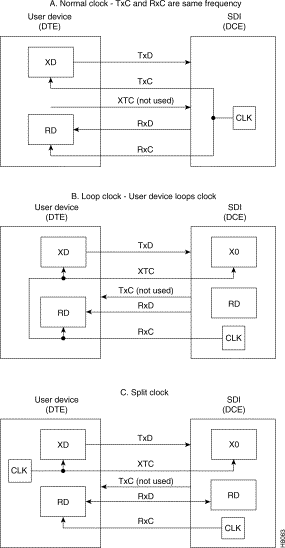

Isochronous clocking lets a node at the far end compensate for an unstable clock in a near-end device. Transmission in an isochronous network is reliable up to 112 Kbps. Only one input per port at a time can use isochronous clocking. The SDI does not support two isochronous clock inputs in the same direction (as required by some modems that independently generate TxC and RxC).
Split clocking uses the user-device timing for timing data transmission in one direction and the IGX timing for the other direction.
The LDM front card supports up to 8 synchronous or asynchronous data ports. Each port is independently configurable for DTE or DCE mode, baud rate, and so on. The LDM card is a low speed data module for use on EIA/TIA-232C ports with data rates up to 19.2 Kbps, where the higher speed capabilities of an HDM are unnecessary.
The LDM can process either synchronous or non-synchronous input data. With non-synchronous inputs, the data is over-sampled at a rate determined by how much jitter your equipment can tolerate. Using an external device is also possible for synchronizing the asynchronous data before the data enters the IGX node.
The LDM front data card:
Additional features, such as embedded (fast) EIA, sixth EIA lead support, and pleisochronous clocking, are also supported. The fast EIA control lead lets the user include the RTS/CTS EIA control leads in the same FastPacket as customer data. The EIA control lead status is encoded as the eighth data bit in each data byte. This provides a quick EIA response without significantly affecting bandwidth requirements. It is limited to data rates of 19.2 Kbps and below.
The LDM can reside in any empty front slot and requires an LDI back card. The LDI card plugs directly into the P2 connector of the LDM card.
The faceplate of the LDM has message lights and buttons for loopback control and signal monitoring. Figure 4-56 shows and Table 4-52 lists these indicators and buttons. When correlating the figure to the table, read from the top down. The buttons are for loopback testing and scrolling through the FastPacket data ports to obtain a snapshot of selected port conditions (indicated by Port, Port Under Test, loopback, and communication line status lights).

| Faceplate Item | Function |
Port Readout Display | Indicates which FastPacket port (1-8) on the back card is currently viewed. |
Scroll push-button | When pressed, toggles through the ports. Information displayed by other LEDs on the faceplate applies to the port shown by the 7-segment display. |
Loopback push-button | When pressed, toggles through the three loopback states on the port whose light is on. These states are: no loopback, local loopback, remote loopback. |
Port under test light | Indicates that a port has gone into the loopback mode. If this is not the current port, push the Scroll button to toggle in the port being tested. |
LL light (yellow) | Indicates that a local loopback is occurring on one of the ports. |
RL light (yellow) | Indicates a remote loopback is occurring on one a port. |
DTR light (green) | Indicates the Data Terminal Ready signal is ON at the selected port terminal. |
TXD light (green) | Indicates the Transmit Data signal is ON at the selected port terminal. |
DCD light (green) | Indicates the Data Carrier Detect signal is ON at the selected port terminal. |
RXD light (green) | Indicates that the Receive Data signal is ON at the selected port. |
Fail light (red) | Indicates an error occurred. Reset the card with the resetcd f command. If the LED comes on again, call the TAC. |
Active light (green) | Indicates that the card is active and functioning normally. |
Redundancy for LDM data card types is available through a second front and back card set and a Y-cable connection on each port to the customer data equipment. Figure 4-57 illustrates redundancy.

The 4-port and 8-port LDM supports only a subset of the full EIA/TIA-232C/D control leads. The LDM supports only non-isochronous DCE normal and DCE or DTE looped clocking modes, transmission of 3 EIA lead states (non-interleaved), and baud rates of up to 19.2 Kbps on the 8-port version and 38.4 Kbps on the 4-port version. Split clock mode is not supported.
The Low-Speed Data Interface (LDI) card is a low-speed data interface back card that operates in conjunction with an LDM front card. The LDI provides the physical and electrical connection interface between the user low-speed data circuit and the LDM data PAD. Three models of the LDI exist. Two are four-port cards, and one is an eight-port card, as Table 4-53 indicates.
Some of the functions and features of the LDI are:
| Card | Interface | Ports | Connector |
LDI 4 | EIA/TIA-232C/D (V.24) | 4 ports | DB15 Subminiature, female |
LDI 8 | EIA/TIA-232C/D (V.24) | 8 ports | DB15 Subminiature, female |
The LDI can operate either as a DCE or DTE. Selection is made by using a Cisco DTE or DCE adapter cable between the port connector and the cable from the user device. This cable is terminated with a standard DB25 on the customer end. Each port is configured separately.
Three EIA control leads are brought out to the rear connectors, three when used as a DCE and three for DTE. Table 4-54 lists these leads.
| Leads for DCE | Leads for DTE |
RTS | CTS |
DSR | DTR |
DCD | RL |
The RL lead allows the use of a previously unused DTE EIA output lead. You can use remote loopback (RL) to enable a far-end modem loopback. Local loopback (LL) is not provided as an output on the LDI. If local loopback is required, use the DTR lead by wiring it to the connector pin for local loopback.
The LDI supports two clocking modes: normal and looped (see Figure 4-58). The normal mode is used when the LDI port is configured as a DCE. Looped clock is only used when the LDI port is configured as a DTE. The user device must take the external transmit clock and loop it back to the RxC for clocking in the receive-data. In both cases, the LDI is the source of clock timing. Table 4-55 shows the accuracy and worst case jitter that can be expected from an end-to-end circuit using LDIs at each end.
| Bit Rate | Accuracy | Worst-Case Jitter |
1200 | .06 | .03 |
2400 | .12 | .06 |
4800 | .24 | .12 |
9600 | .48 | .23 |
14,400 | .72 | .35 |
19,200 | .96 | .47 |
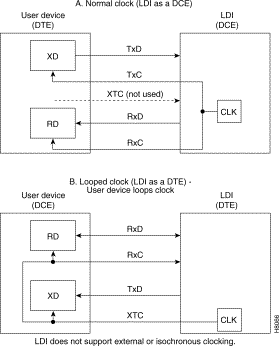
At least one node in a network has a StrataView Plus terminal, a control terminal, or a dial-in modem connected to it. Any control terminal connected in the network can configure, manage, monitor, and diagnose the entire network. In addition, at least one node in a network may have a connected printer for error and event reports.
The control terminal and printer connect to two EIA/TIA-232 serial ports. These ports are the Control Terminal and Auxiliary Port on the SCM faceplate. These serial ports support all standard asynchronous data rates from 1200 to 19,200 baud. The default rate is 9600 baud. Data rates and the type of equipment connected to the ports are software-configurable.
Cisco recommends that at least one IGX in the network connects to a direct-dial modem so that TAC personnel can perform remote diagnostic tests. (Contact the TAC through Customer Engineering.) A direct-dial modem connects to the backplane at the Control Terminal port. In addition, an auto-dial modem can be connected to the AUX port connector on the SCM at any node in the network so that remote error messages and alarms can be sent to the Cisco TAC.
An external clock source can be connected to the SCM card using the external clock adapter cable. The external clock device can be either 1.544 MHz or 2.048 MHz EIA/TIA-422 square wave signals depending on the primary application of the IGX (T1 or E1). Selection is made through software. The clock stability should be at least as good as a Stratum 3 clock source. The Cisco IGX 8400 Series Installation manual lists the terminals, printers, modems, and clock sources that have been tested and approved for use with an IGX switch.
![]()
![]()
![]()
![]()
![]()
![]()
![]()
![]()
Posted: Wed Sep 11 14:20:05 PDT 2002
All contents are Copyright © 1992--2002 Cisco Systems, Inc. All rights reserved.
Important Notices and Privacy Statement.